NEC of America FOMA-N906IL PCS GSM Phone with RFID User Manual E03 Tel1
NEC Corporation of America PCS GSM Phone with RFID E03 Tel1
Users Manual
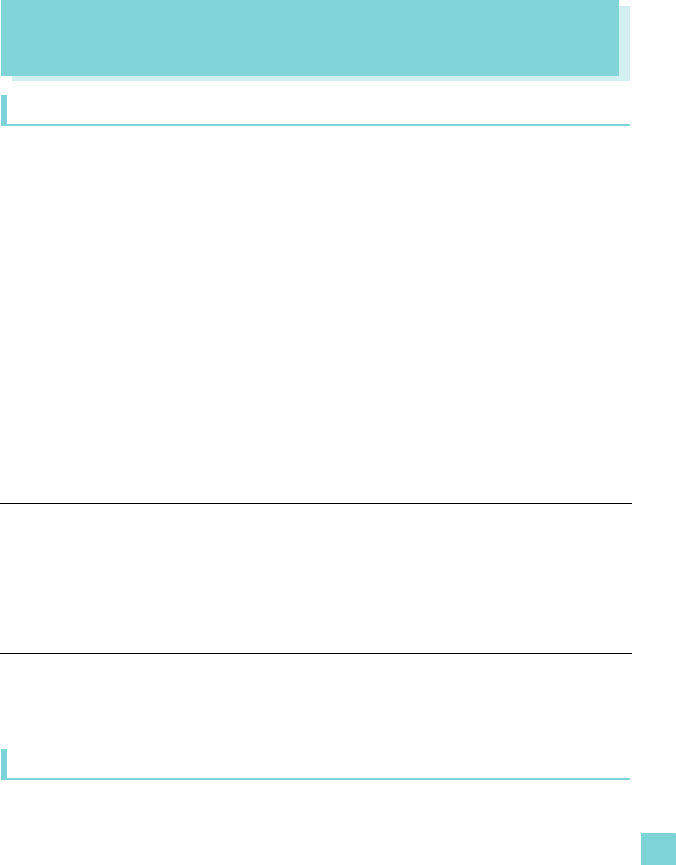
433
SAR
Specific Absorption Rate of Mobile Phones,
etc.
Specific Absorption Rate (SAR)
This model phone FOMA N906iL meets the MIC’s*1 technical regulation for exposure to radio waves.
The technical regulation established permitted levels of radio frequency energy, based on standards
that were developed by independent scientific organizations through periodic and thorough evaluation
of scientific studies. The regulation employs a unit of measurement known as the Specific Absorption
Rate, or SAR. The SAR limit is 2 watts/kilogram (W/kg)*2 averaged over ten grams of tissue. The limit
includes a substantial safety margin designed to assure the safety of all persons, regardless of age
and health. The value of the limit is equal to the international guidelines recommended by ICNIRP*3.
All phone models should be confirmed to comply with the regulation, before they are available for sale
to the public. The highest SAR value for this model phone FOMA N906iL is 0.32 W/kg. It was taken
by the Telecom Engineering Center (TELEC), a Registered Certification Agency on the Radio Law.
The test for SAR was conducted in accordance with the MIC testing procedure using standard
operating positions with the phone transmitting at its highest permitted power level in all tested
frequency bands. While there may be differences between the SAR levels of various phones and at
various positions, they all meet the MIC’s technical regulation. Although the SAR is determined at the
highest certified power level, the actual SAR of the phone during operation can be well below the
maximum value.
For further information about SAR, please visit the following websites:
Radio Frequency (RF) Signals
THIS MODEL PHONE MEETS THE U.S. GOVERNMENT'S REQUIREMENTS FOR EXPOSURE TO
RADIO WAVES.
Your wireless phone contains a radio transmitter and receiver. Your phone is designed and
manufactured not to exceed the emission limits for exposure to radio frequency (RF) energy set by the
Federal Communications Commission of the U.S. Government. These limits are part of comprehensive
guidelines and establish permitted levels of RF energy for the general population. The guidelines are
based on standards that were developed by independent scientific organizations through periodic and
thorough evaluation of scientific studies.
World Health Organization (WHO): http://www.who.int/peh-emf/
ICNIRP: http://www.icnirp.de/
MIC: http://www.tele.soumu.go.jp/e/ele/body/index.htm
TELEC: http://www.telec.or.jp/ENG/Index_e.htm
NTT DoCoMo: http://www.nttdocomo.co.jp/english/product/
NEC: http://www.n-keitai.com/lineup/ (in Japanese only)
Association of Radio Industries and Businesses: http://www.arib-emf.org/index.html (in Japanese
only)
*1:Ministry of Internet Affairs and Communications
*2:The technical regulation is provided in Article 14-2 of the Ministry Ordinance Regulating
Radio Equipment.
*3:International Commission on Non-lonizing Radiation Protection
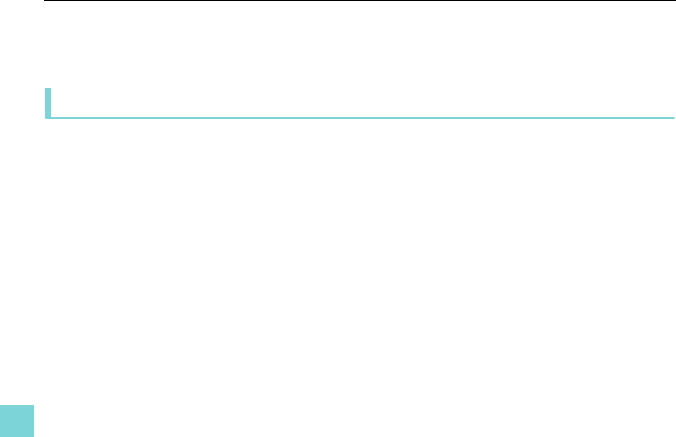
434
SAR
The exposure standard for wireless mobile phones employs a unit of measurement known as the
Specific Absorption Rate (SAR). The SAR limit set by the FCC is 1.6 W/kg.* Tests for SAR are
conducted using standard operating positions accepted by the FCC with the phone transmitting at its
highest certified power level in all tested frequency bands. Although the SAR is determined at the
highest certified power level, the actual SAR level of the phone while operating can be well below the
maximum value. This is because the phone is designed to operate at multiple power levels so as to
use only the power required to reach the network. In general, the closer you are to a wireless base
station antenna, the lower the output.
Before a phone model is available for sale to the public, it must be tested and certified to the FCC that
it does not exceed the limit established by the U.S. government-adopted requirement for safe
exposure. The tests are performed on position and locations (for example, at the ear and worn on the
body) as required by FCC for each model. The highest SAR value for this model phone as reported to
the FCC when tested for use at the ear is 0.22 W/kg, and when worn on the body, is 0.32 W/kg.
(Body-worn measurements differ among phone models, depending upon available accessories and
FCC requirements). While there may be differences between the SAR levels of various phones and at
various positions, they all meet the U.S. government requirement.
The FCC has granted an Equipment Authorization for this model phone with all reported SAR levels
evaluated as in compliance with the FCC RF exposure guidelines. SAR information on this model
phone is on file with the FCC and can be found under the Display Grant section at https://
gullfoss2.fcc.gov/oetcf/eas/reports/GenericSearch.cfm after search on FCC ID A98-FOMA-N906IL.
For body worn operation, this phone has been tested and meets the FCC RF exposure guidelines
when used with an accessory designated for this product or when used with an accessory that
contains no metal and that positions the handset a minimum of 1.5 cm from the body.
FCC Regulations
This mobile phone complies with part 15 of the FCC Rules. Operation is subject to the following two
conditions: (1) This device may not cause harmful interference, and (2) this device must accept any
interference received, including interference that may cause undesired operation.
This mobile phone has been tested and found to comply with the limits for a Class B digital device,
pursuant to Part 15 of the FCC Rules. These limits are designed to provide reasonable protection
against harmful interference in a residential installation. This equipment generates, uses and can
radiate radio frequency energy and, if not installed and used in accordance with the instructions, may
cause harmful interference to radio communications. However, there is no guarantee that interference
will not occur in a particular installation; if this equipment does cause harmful interference to radio or
television reception, which can be determined by turning the equipment off and on, the user is
encouraged to try to correct the interference by one or more of the following measures:
eReorient or relocate the receiving antenna.
eIncrease the separation between the equipment and receiver.
eConnect the equipment into an outlet on a circuit different from that to which the receiver is connected.
eConsult the dealer or an experienced radio/TV technician for help.
Changes or modifications not expressly approved by the party responsible for compliance could void
the user’s authority to operate the equipment.
*In the United States, the SAR limit for wireless mobile phones used by the public is 1.6 watts/kg (W/
kg) averaged over one gram of tissue. SAR values may vary depending upon national reporting
requirements and the network band.
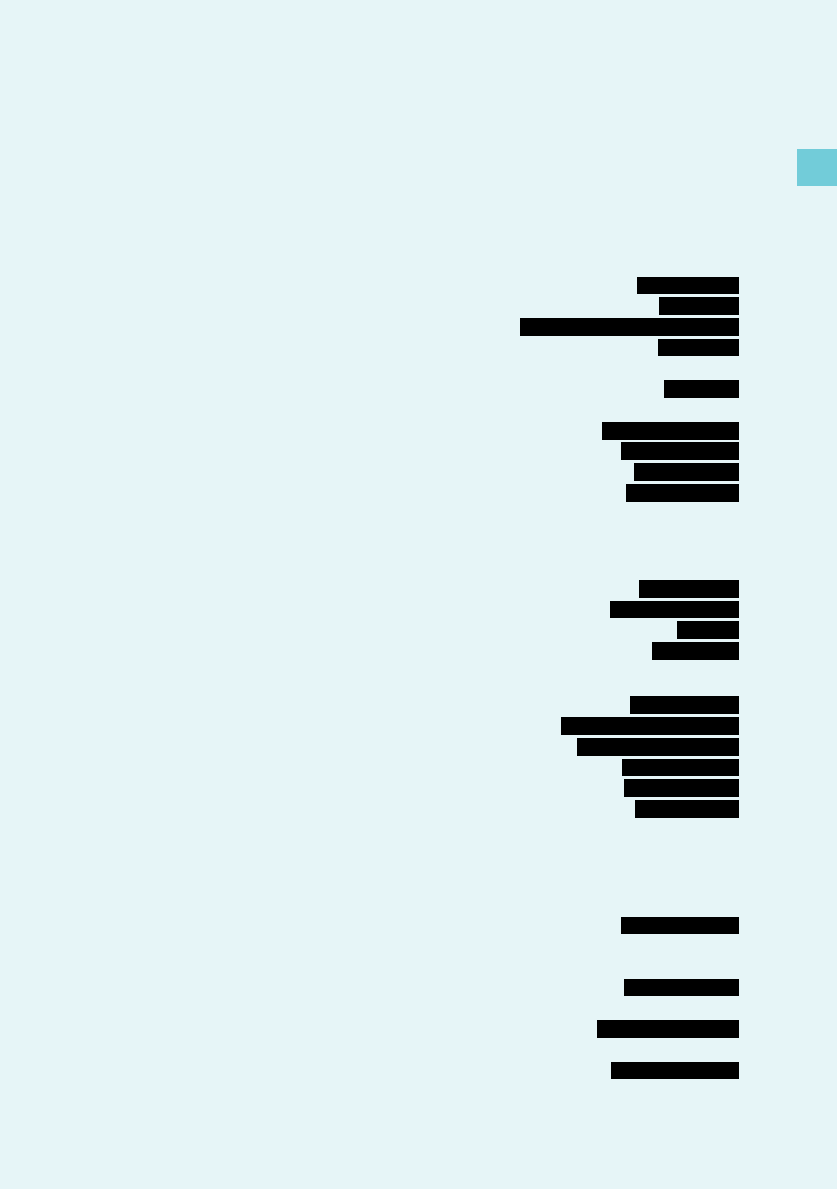
1
Voice/Videophone Calls
■Making a Voice/Videophone Call
FOMA Making a Voice/Videophone Call......................................................................... 2
Switching a Voice/Videophone Call During a Call (Caller).............................................. 5
Using International Call............................................................................. 6
Using Handsfree Operation During a Call ..................................................... 8
Using the Redial/Dialed Calls/Received Calls Record.... 8
Using Chaku-moji ......................................................................................... 11
Setting Caller ID Notification........................................................................................... 12
Sending Push Signals..................................................................................... 13
Using the Prefix Function................................................................................................ 14
Setting Sub-addresses When Making Calls ..................................... 15
Setting the Alarm Used for Reconnection............................................. 15
Blocking Out Ambient Noise .................................................................... 15
Making Handsfree Calls in the Car ........................................................ 15
■Receiving a Voice/Videophone Call
Receiving FOMA Voice/Videophone Calls...................................................................... 16
When the Other Party Switches FOMA Voice/Videophone Calls (Caller)....................... 17
Using the Dial Keys to Answer a Call........................................................ 17
Ending/Holding Calls with the FOMA Terminal Folded ....................... 18
Adjusting the Earpiece Volume.......................................................................... 18
Adjusting the Volume of Ring Tone .............................................................. 19
■Settings for when you cannot take calls
Holding the Ringing/Current Call ............................................................ 19
Using the Public Mode (Driving Mode) .................................... 20
Using the Public Mode (Power OFF) .......................................... 21
Setting the Notification Method for Missed Calls .................................. 22
Having the Caller Leave a Message ...................................................... 23
Having Callers Leave a Message During an Incoming Call..................... 24
Playing/Erasing Recorded Messages, Voice Memos and Video Memos........................ 25
■Setting the Videophone
Using Chara-den............................................................................................................. 26
Selecting the Image Sent to the Other Party .................................................................. 26
Setting the Hands-free Operation for Videophone Calls....................... 28
Setting the Image Displayed During a Videophone Call................................................. 28
Setting for Switching Between FOMA Voice Call and Videophone Call
....................................................................................................................... 29
Setting the Answer Mode When You Receive a Videophone Call During i-mode
................................................................................................................. 29
Using the Videophone Connecting to External Devices ................................................. 30
Remote Monitoring ............................................................................. 30
WORLD CALL
Hands-free
Redial/Dialed calls/Received calls
Chaku-moji
Pause dial
Sub-address setting
Reconnect signal
Noise reduction
In-car hands-free
Answer setting
Setting when folded
Volume
Ring volume
On hold/Holding
Public mode (Driving mode)
Public mode (PowerOFF)
Info notice setting
Record message
Quick message
Hands-free switch
Ntfy switch-mode
V-phone while packet
Remote monitoring
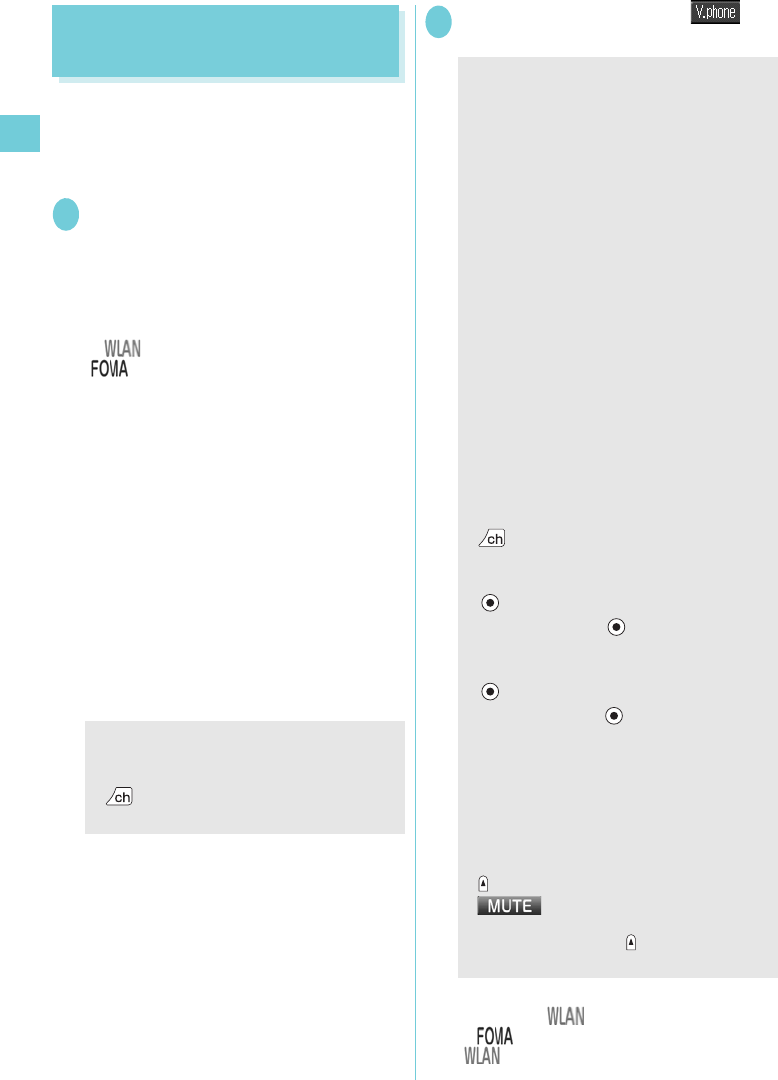
2
Voice/Videophone Calls
Making FOMA Voice/
Videophone Calls
zFOMA voice calls/videophone calls cannot be
made in WLAN single mode.
zIn DUAL mode (FOMA prefer/WLAN prefer), FOMA
voice call/videophone call or WLAN voice call can
be selected while entering a phone number.
1Dial the phone number starting with
the other party’s area code
The “Enter phone number” screen appears.
Always start by entering the area code, even for
calls within the same area.
If the number exceeds 26 digits, last 26 digits
are displayed. You can dial up to 80 digits.
If “ ” is displayed, press d to display
“”.
<When you enter a wrong number>
■To insert a number
Press v to move the cursor to the number to
the left of the position where you want to insert
the number, then enter the number.
■To delete a number
Press v to move the cursor to the number you
want to delete, then press t.
Hold down t for 1 second or longer to delete
all the numbers to the left of the cursor and the
number in the cursor position.
■To reenter the number
Move the cursor to the beginning or end of the
number and hold down t for 1 second or
longer to return to the standby screen.
2r (FOMA voice call)/o ()
(videophone call)
■To make a WLAN voice call
XVerify that “ ” is displayed, and press r
If “ ” is displayed, press d to display
“ ”, then press d again.
<Videophone>
■To make a videophone call with Chara-
den
X (FUNC)X“Select image”X“Chara-
den”XSelect Chara-den
<FOMA Voice Call>
The “FOMA voice in-call” screen appears.
■If you hear the busy tone
The line is busy. Call again after a while.
■If you hear a message saying that the
other party cannot be reached
The other party’s mobile phone is not turned
on or is out of signal range. Call again after a
while.
■If you hear a message requesting your
caller ID
The other party sets the Caller ID Request
service to “Activate”. Call again with caller ID
notified.
<Videophone>
The “Videophone in-call” screen appears.
You will hear the other party’s voice from the
speaker and you can start talking.
■If a videophone call is not connected →
p.5
■To switch between camera image and
substitute image
X (FUNC)X“Substitute image” or “My
side”
■To send video from the rear camera
X (Change)
Each time you press (Change), the front
camera/rear camera switches.
■To switch the main screen
X (1 second or longer)
Each time you press (1 second or longer),
the screen switches in the following order:
Other party’s image on the main screen→
Your own camera image on the main screen→
Display only the other party’s image →Display
only your own camera image
■To mute the voice to send (Microphone
mute)
X (マナー ) (1 second or longer)
“ ” appears while the voice is muted.
The video image sending is continued.
To cancel muting, press (マナー ) for 1
second or longer again.
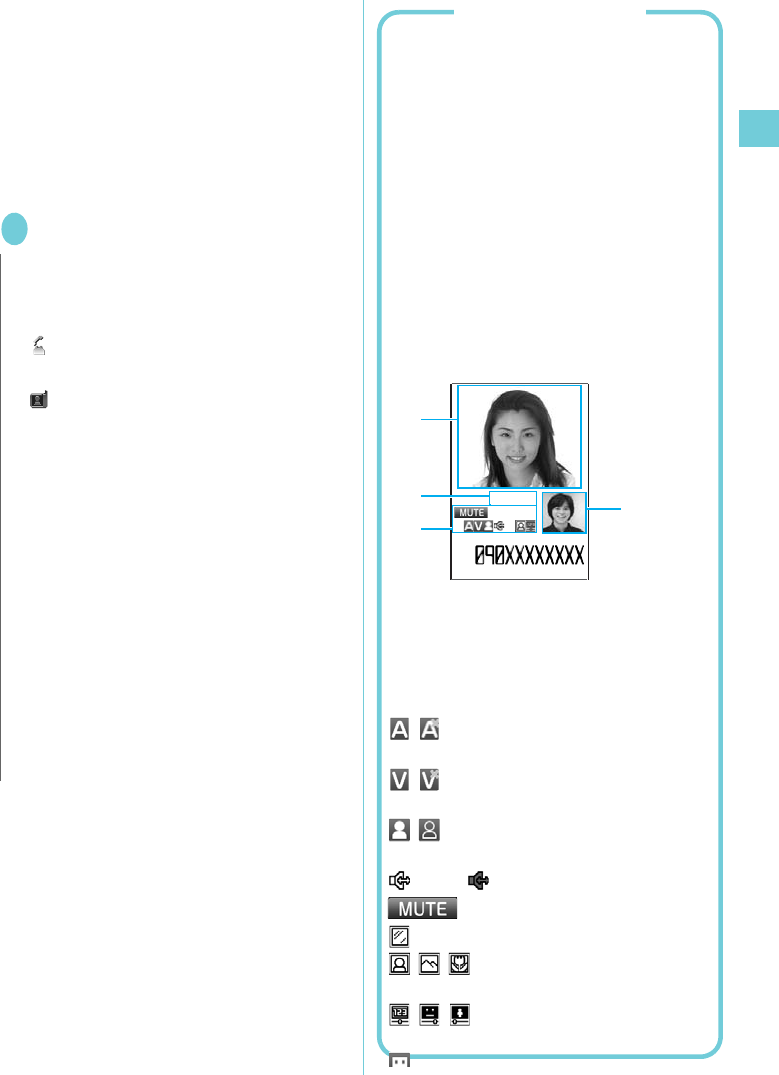
3
Voice/Videophone Calls
■To change between FOMA voice call/
videophone call during a call (caller)
“Switching FOMA Voice/Videophone Call During
a Call (Caller)”→p.5
■To put the current voice/videophone call
on hold
“Holding the Ringing/Current Call” →p.19
■When 2in1 is in Dual mode
The Outgoing number selection screen appears.
Select a phone number.
3To end the call, pressy
N
zWhen talking in View style, you can hear the other’s
voice, but cannot send your voice. Use Normal style.
<FOMA Voice Call>
z“ ” flashes while dialing and lights up during the
call.
<Videophone call>
z“ ” flashes while dialing a videophone call and lights
up during the call.
zIf you make a videophone call to an emergency
number (110, 119 or 118) from the FOMA terminal,
the call is automatically changed to a FOMA voice call.
zYou cannot receive i-mode mail or a MessageR/F
during a videophone call (you can receive SMS,
instant message or presence report). Received mail is
kept at the i-mode Center and can be retrieved using
“Check new messages” after the videophone call.
zIf the low-voltage alarm “Recharge battery” appears
on the display during a videophone call, the other
party sees the “カメラオフ Camera Off” message
and the call is disconnected about 20 seconds later. If
you start charging battery before the call is
terminated, the videophone call continues with the
image that had been displayed before the low-voltage
alarm.
zDigital communication charges are still applied when
the substitute image is displayed during a videophone
call.
What is the Videophone
You can use the videophone call function
between the terminals that support the DoCoMo
videophone system.
zDoCoMo videophone conforms to the 3G-
324M*1 standard set down in the international
3GPP*2 standards. Your FOMA terminal cannot
connect to a videophone terminal that uses a
different system from DoCoMo videophones.
*2: 3GPP (3rd Generation Partnership Project) A
regional standardization body established to
develop commonly applied technical
specifications for 3rd-generation mobile
communications systems (IMT-2000).
*1: 3G-324MAn international standard for 3rd-
generation mobile videophones.
zThere are 2 types of connection speed (64K
(64kbps)/32K (32kbps)) for the videophone, but
the onefone cannot use the videophone in 32K.
■How to view the videophone screen
①Main screen (Camera image of the other party
is displayed at the time of purchase)
②Sub-screen (Your own camera image is
displayed at the time of purchase)
③Call duration
④Settings
: Sending or receiving voice/
Transmission error
: Sending or receiving video/
Transmission error
: Sending camera image/Sending
substitute image
(white) (gray): Handsfree ON/OFF
: Muting the microphone
: Visual check in progress
: Photo mode (Portrait/Scenery/
Close-up)
: Key operation mode (DTMF
mode*1/Whole action mode*2/
1
分
32
秒
11
33
22
44
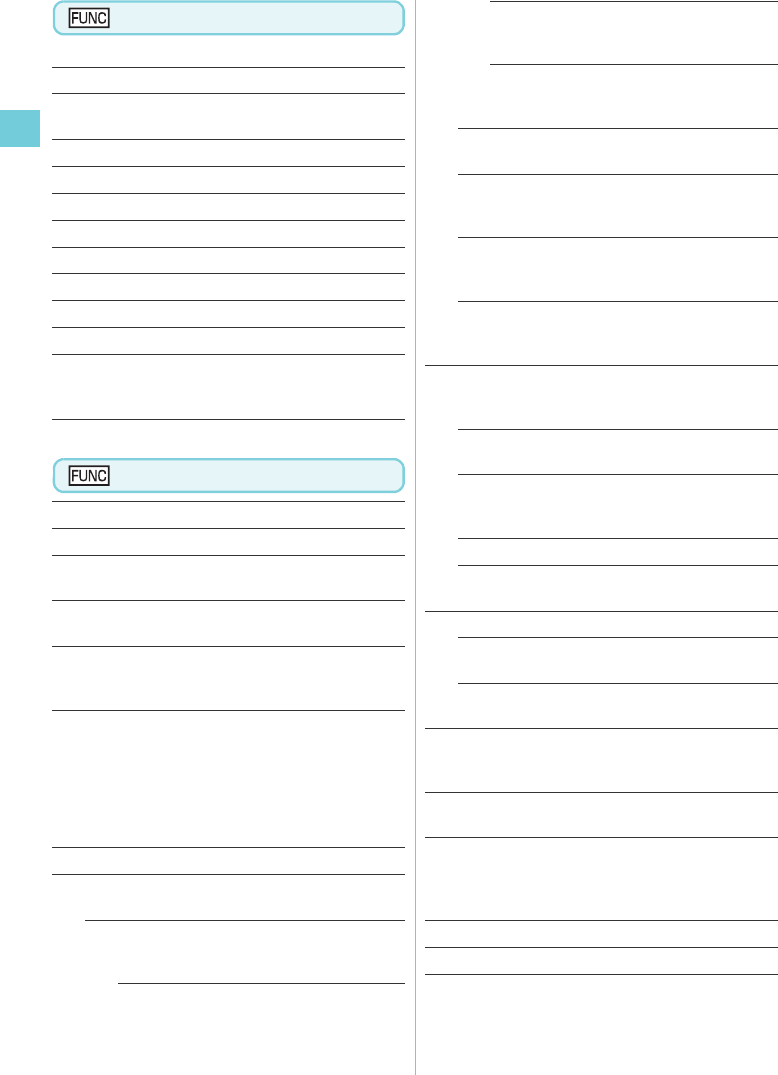
4
Voice/Videophone Calls
Enter phone number screen
(p.2)
Sending mode*……Select FOMA or WLAN for dialing.
Inp. SIP address……Shows the SIP address entry
screen.
Notify Caller ID→p.13
Prefix numbers→p.15
Prefix……Enters a prefix for a WLAN voice call.
Chaku-moji→p.11
Int’l call→p.7
Multi Number
Add to phonebook
Compose message*
Select image……Selects the image used during a
videophone call from “My side”/“Chara-den”. Select
“Release settings” to cancel the setting.
*: This function is unavailable when 2in1 mode is in B mode.
Videophone in-call screen (p.2)
Petit message→p.29
Decoration→p.28
Off decoration……Deletes the displayed message or
stamp.
Substitute image ⇔My side……Switches between the
camera image and the substitute image.
Front camera⇔Rear camera……Switches between
front camera and rear camera. This setting is only
retained during the call.
Change main disp.……Change the main display. The
screen changes in the order of “Displaying the image from
the other party’s camera on your main screen.”→
“Displaying the image from your own camera on your
main screen.” →“Displaying only the image from the other
party’s camera.”→“Displaying only the image from your
own camera.”
Visual check ⇔Visual check off→p.27
V.phone settings……Sets the screen for videophone
call.
Visual prefer……Sets the image sent to and
received from the other party. This setting is only
retained during the call.
Normal (default)……Standard setting for both
quality and movement.
Prefer img qual……Sends more finely
detailed video images. Best for motionless
subjects.
Prefer motion spd……Sends video images
with smooth movement. Best for fast-moving
subjects.
Brightness……Five brightness levels (-2 to 0 to +2)
are available.
White balance……Sets image color tones. This
setting is also applied to the equivalent camera
functions.
Color mode set……Selects the effect for the movie
from “Normal”/“Sepia”/“Monochrome”. This setting is
only retained during the call.
Photo mode……Sets modes suited to the scene
being shot. This setting cannot be set for the front
camera.
Chara-den set.……You can set the following when
Chara-den is used. This setting cannot be set for the
camera images.
Switch Chara-den……Selects the character to be
displayed.
Action List……Checks the available actions and
the corresponding keys. You can also view the action
list by pressing w.
Change Action……Changes the Action mode.
Switch image……Displays your own custom image
on the other party’s display. →p.26
Display light……Sets lighting of backlight.
All time ON (default)……Turns the backlight on all
the time.
10 seconds ON……Turns the backlight on for 10
seconds only.
Front camera Reverse……Sets whether to display your
camera image as a mirror image (ON) or normal image
(OFF) on the FOMA terminal during a call.
Own number……Displays your phone number during a
videophone call.
Send DTMF tone⇔DTMF tone OFF……Sets/cancels
push signal transmission mode during Chara-den.Except
for Chara-den, videophone calls are always in push signal
transmission mode.
Change to voice→p.5
Loc. notification
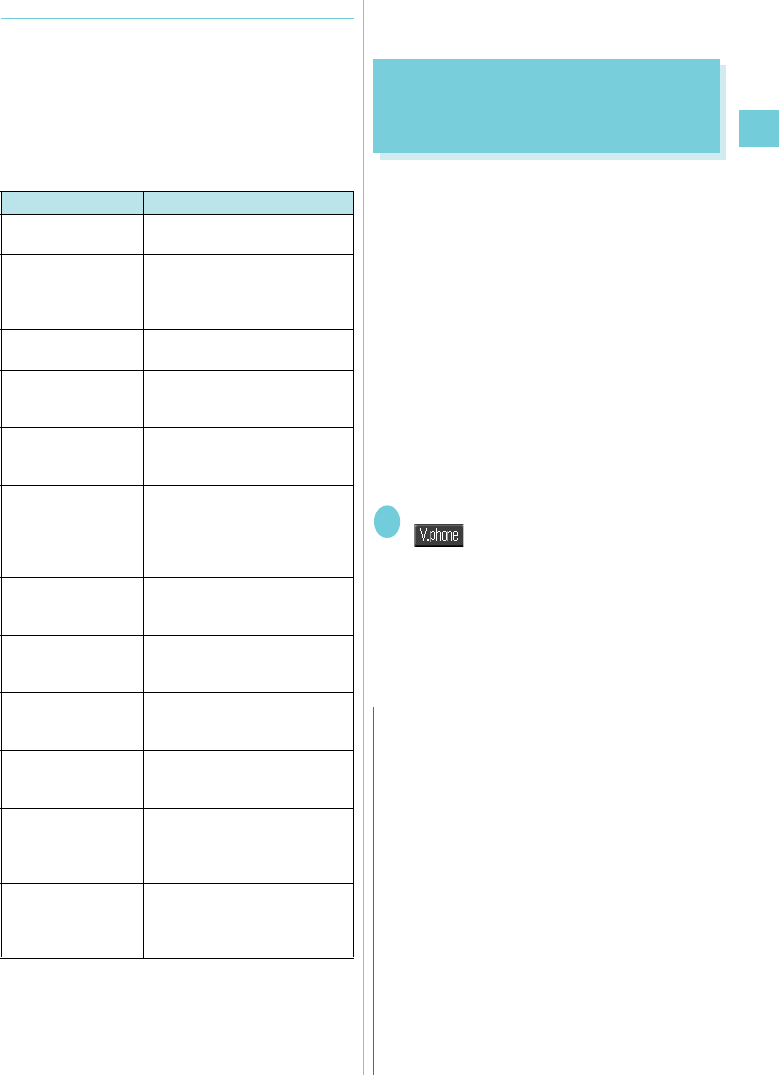
5
Continued on next page
Voice/Videophone Calls
●If a videophone call is not connected
When a videophone call is not connected, the cause
of the failure appears.
zThe cause may not appear depending on the
situation.
zDepending on the type of other party’s phone or the
possible lack of a network service subscription, the
reason may not accurately reflect the other party’s
actual status.
zIf the videophone call is not connected, your call is
automatically switched to a FOMA voice call when
you set “Auto redial as voice” to “ON”. However, the
call may not be handled in this way if you call an
ISDN synchronous 64K or ISDN videophone which
does not support the 3G-324M standard (as of
May, 2008) or if you dial a wrong number. Note that
call charge may be applied in some cases.
Switching FOMA Voice/
Videophone Call During a Call
(Caller)
zIf the handset of the other party is the FOMA
terminal supporting the call switch, you can switch
between FOMA voice call and videophone call.
(This function is available in communications
between voice call and videophone call switchable
terminals.)
zYou can switch the voice call only when you are the
caller.
zTo switch the call, the receiver needs to set “Ntfy
switch-mode” to notify the switch beforehand.→
p.29
zYou can switch FOMA voice/videophone calls
repeatedly.
zWLAN voice call and videophone call cannot be
changed.
<Example: To switch a FOMA voice call to a videophone
call>
1FOMA voice in-call screen (p.2)Xd
()X“YES”
While switching, the screen which indicates that
the calls are being switched appears and the
voice guidance is played.
■To switch a videophone call to a FOMA
voice call
XVideophone in-call screen (p.2)Xu
(FUNC)X“Change to voice”
Display Cause
Check number then
redial
The called phone number is not
used
Busy The line is busy
• This message may also
appear during packet
communication.
Busy with packet
transmission
The other party is using packet
communication
Out of service area/
power off
The other party is out of FOMA
service area or the phone is
turned off
Set caller ID to ON You connected without notifying
your caller ID (when dialing into
Visualnet, etc.)
Your call is being
forwarded
The call is being forwarded (A
Videophone call is made when
the forwarding number is for a
3G-324M-compatible
videophone)
Redial using voice
call
The phone for the forwarding
number is not compatible with
videophone calls
Please activate
caller ID before
dialing again
The other party sets the Caller
ID request service
At the user’s
request, your call
cannot be connected
The other party sets the
Nuisance call blocking service
Upper limit has been
exceeded
Connection failed
The upper limit set for a Limit
billing plan (Type Limit and
Family Wide Limit) is exceeded
Connection failed Set the caller ID notification to
“ON” and retry
• This message may also
appear in other situations
Please make your
call from the i-mode
web page
You attempted to make a
videophone call to watch V-line
without browsing the i-mode
official site
N
zIt takes about 5 seconds to switch the calls. Note that
the signal quality may affect how long it takes.
zYou cannot switch the calls during calling in the
following cases:
• When the other party is holding the call
• When the other party activates Record message
zThe displayed call duration is reset to 0 second each
time the calls are switched. However, after switching, if
the videophone call is finished, the displayed call time
is the total of FOMA voice call and videophone call.
The time took for switching is excluded from the call
duration.
zDepending on the other party’s communication
conditions or the signal quality, you may not be able to
switch the calls and the call may be canceled.
zWhen the call is switched, the first dialed call is
registered to the Redial/Dialed calls records. The first
received call is registered to the Received calls record.
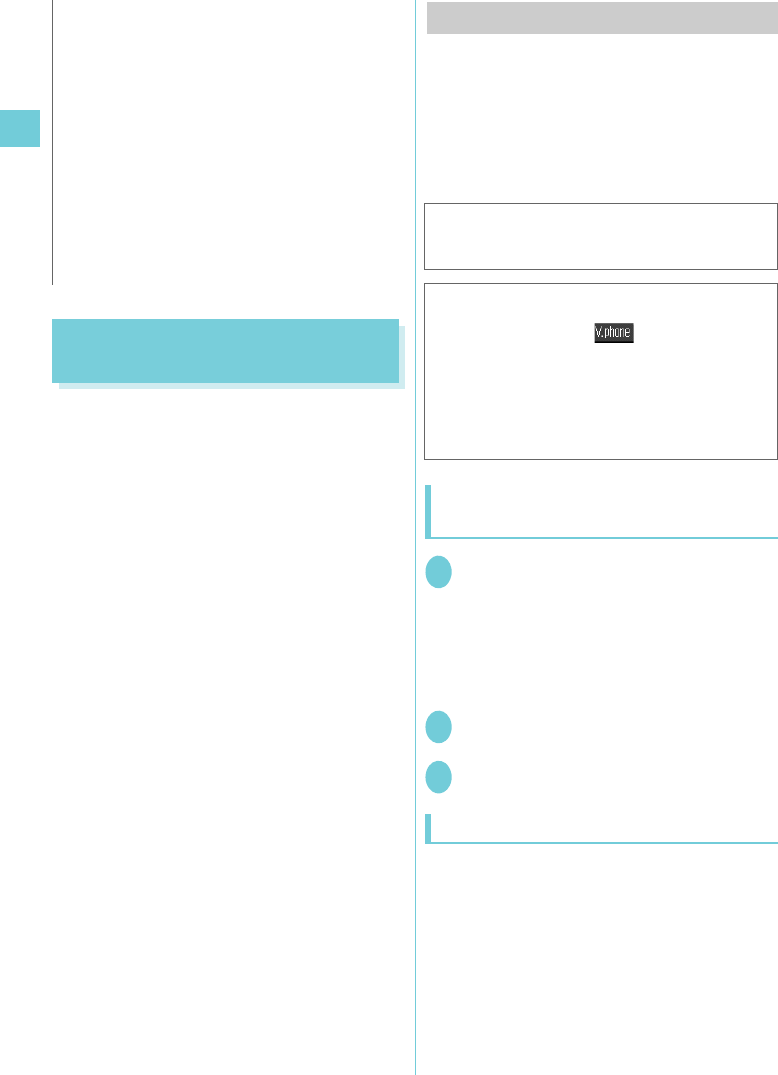
6
Voice/Videophone Calls
Using International Call
<WORLD CALL>
WORLD CALL is an international call service that can
be used on a DoCoMo’s mobile phone.
You subscribed to “WORLD CALL” at the time of
FOMA service contract (except if you reject
subscription).
zCalls can be made to about 240 countries and
areas.
z“WORLD CALL” charges are combined with
monthly FOMA call charges.
zTo make an international call, enter a phone
number directly, use “+”, or select “Int’l call” or
“Prefix numbers” from the Phone number entry,
Redial/Dialed calls, Received calls or Phonebook
detail function menus.
zThis service is not available in some payment
plans.
International calling order change
Mobile phones and other mobile communications are
not included in the “MYLINE” service, and the
“MYLINE” service is not available for WORLD CALL.
However, the “MYLINE” service introduction changed
the dialing order for international call made from a
mobile phone, etc. The former dialing order
(excluding “010” from the following dialing order) is
not available.
Making an international call by dialing
a phone number
1Dial the following: 009130 →010→
Country code→Area code (Long
distance code)→The other party’s
phone number
If the area code (long distance code) begins with
“0”, omit the first “0”. When placing a call to a
fixed-line phone in Italy, the initial “0” is required.
2r
International call is made.
3To end the call, press y
Making an international call using “+”
Using “+”, an international call can be made without
dialing an international access code such as 009130-
010.
z“Auto Int’l call set.” under “Int’l dial assistant” is set
to “ON” (Automatically added) at the time of
purchase, and international access code is
automatically dialed.
zFor WLAN voice call, “+” is not converted to
international access code before dialing.
zYou are not charged while “SWITCHING VOICE/
VIDEO” appears.
zIf you switch the calls, the amount of call charge displayed
in “Call data” may differ from the actual one.
<When switching from FOMA voice call to
videophone call>
zIf the caller is using i-mode, the packet communication
is canceled to switch to videophone.
zIf the other party is using packet communication
(including i-mode), you receive the message “No
Switch” meaning you cannot switch the calls and the
FOMA voice call continues.
zYou cannot switch the calls when “Call Waiting” is
activated.
N
If you have further questions regarding WORLD
CALL, contact the inquiries number provided on
the back of this manual.
To make an international videophone to a user of
specific 3G mobile terminal overseas, dial as
follows then press o ().
zSee the DoCoMo’s Website for information on
accessible countries and operators.
zDepending on the other party’s terminal, the image
of the other party displayed on the FOMA terminal
may be distorted or the connection may fail when
making an international videophone.
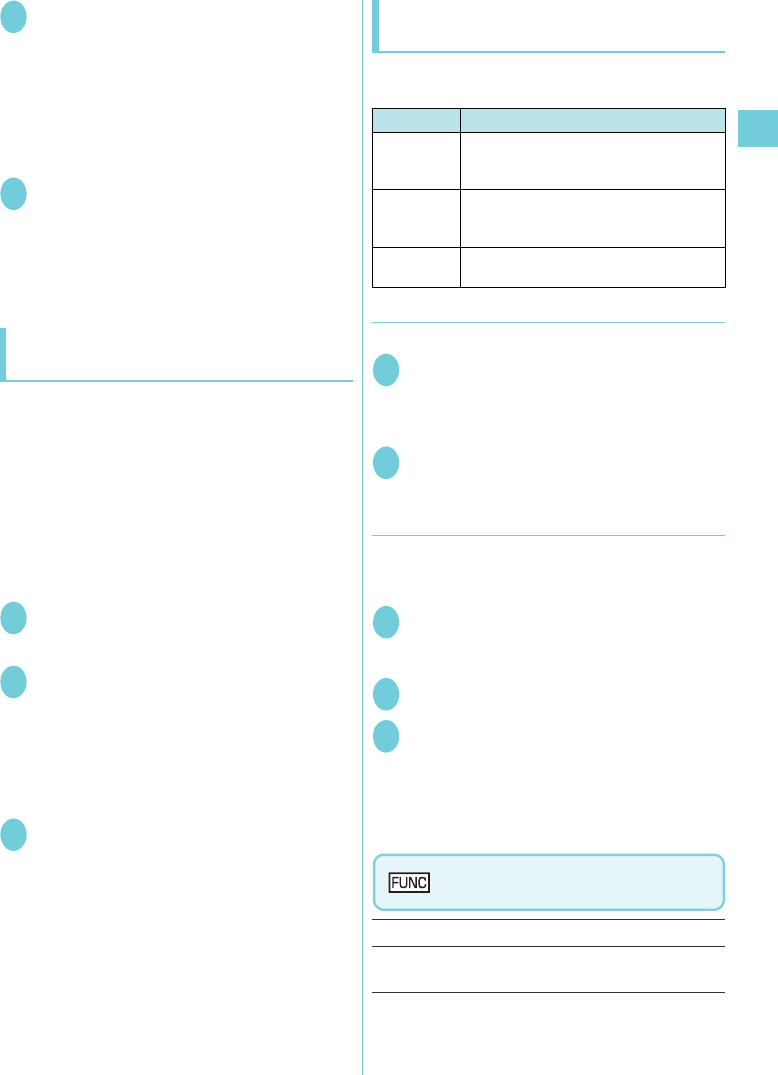
7
Continued on next page
Voice/Videophone Calls
1On the standby screen, dial the
following: + (0 (1 second or longer))
→Country code→Area code (Long
distance code)→The other party’s
phone number
If the area code (long distance code) begins with
“0”, omit the first “0”. When placing a call to a
fixed-line phone in Italy, the initial “0” is required.
2r
X
“Dial”
International call is made.
■To make a call without converting “+” to
international access code
■To cancel calling
X“Cancel”
Making an international call using the
dialing function <Int’l call>
Add a country code or international access code to
make an international call.
zCountry code or international access code can be
added by “Int’l dial assistant”.
zYou can use the international dialing function from
the “Enter phone number” screen and the detail
screens of “Phonebook”/“Received calls”/“Dialed
calls”/“Redial” screens.
<Example: To use the international dialing function
the Enter phone number screen>
1Enter the phone number of the other
party
2u (FUNC)
X
“Int’ call”
X
Select a
country code
X
Select an international
access code
Selected country code and international access
code are added. If the area code begins with “0”,
the initial “0” is automatically deleted (except
when “Italy” is selected for the country code).
3r
Making an international call quickly
<Int’l dial assistance>
Change the settings for making an international call
or edit a country code. The following items can be set:
●Setting “+” auto-conversion
Set “+” auto-conversion for an international call.
1iX“Settings”X“Dialing”XInt’l dial
assistanceXAuto int’l call set.X“ON”
■To cancel auto-conversion
X“OFF”
2Select a country code
X
Select an
international access code
●Editing a country code
Up to 22 country codes can be registered to make an
international call.
For country codes, visit DoCoMo’s website.
1iX“Settings”X“Dialing”X“Int’l dial
assistance”X“Country Code setting”
The “Country Code setting” screen appears.
2Highlight an itemXo (Edit)
3Enter a country name
X
Enter a country
code
You can enter up to 8 double-byte or 16 single-
byte characters for a country name, and 5 digits
for a country code.
Country Code setting screen
(p.7)
Edit……Edits the country code.
Delete……Select “Delete this”, “Delete selected” or
“Delete all”. “About multiple-choice”
Setting Description
Auto int’l
call set.
Automatically converts entered + to the
specified international access code when
making an international call from Japan.
Country
Code
setting
Edits a country name and code used to
make an international call. 22 names and
codes are stored at the time of purchase.
IDD Prefix
setting
Adds an international access name and
code used to make an international call.
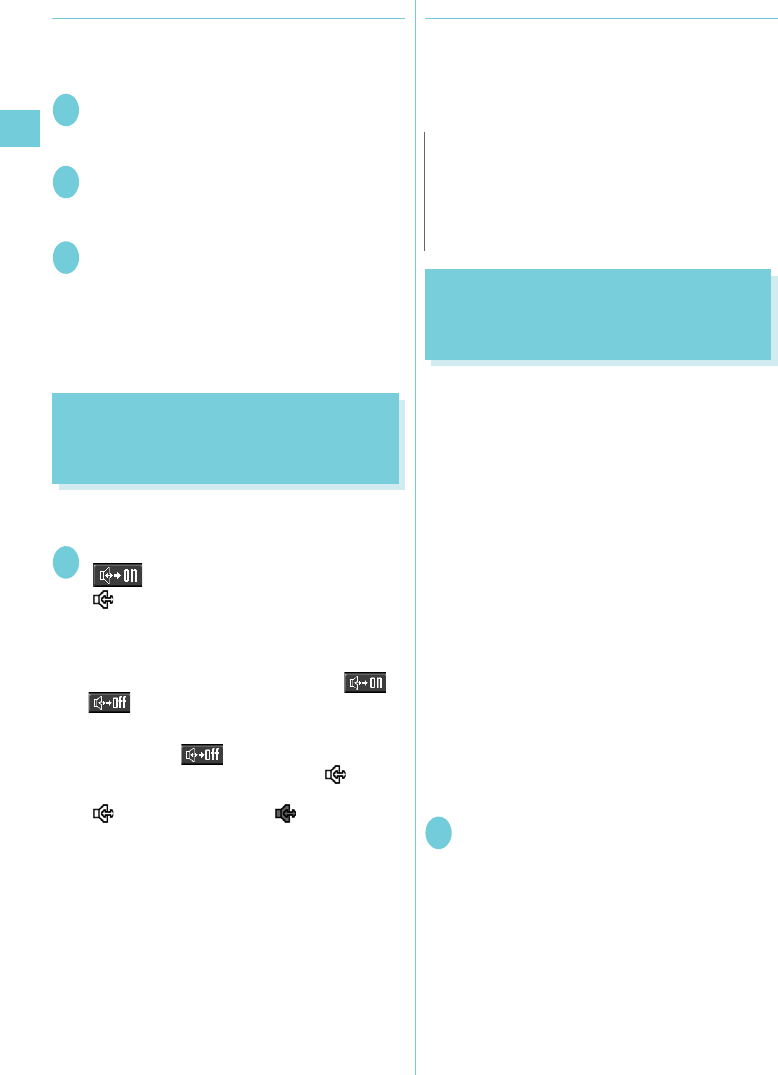
8
Voice/Videophone Calls
●Registering international access codes
Up to 3 international access codes can be registered
to add to the beginning of a phone number when
making an international call.
1i
X
“Settings”
X
“Dialing”
X
“Int’l dial
assistance”
X
“IDD Prefix setting”
The “IDD Prefix setting” screen appears.
2Highlight “<Not recorded>”
X
o (Edit)
■To change an already stored item
XHighlight an item to changeXo (Edit)
3Enter an international access
name
X
Enter an international access
code
You can enter up to 8 double-byte or 16 single-
byte characters for an international access
name, and 10 digits for an international access
code.
Using Handsfree Operation
During a Call
<Hands-free>
You can hear the other party’s voice from the speaker while
talking.
1FOMA voice in-call screen (p.2)Xo
()
“ ” (white) appears and you can hear the
other party’s voice through a speaker during a
handsfree call.
While your terminal is ringing, you can switch to
handsfree operation by pressing o (/
).
■To cancel the handsfree operation
XPress o ( ) during a handsfree call
The handsfree operation ends, and “ ” (white)
disappears in case of voice call or PushTalk.
“ ” (white) is changed to “ ” (gray) in case
of videophone.
●Notes on using the handsfree operation
It is recommended to keep a distance of about 30 cm
from the FOMA terminal during a handsfree call. If
the distance is longer or shorter than 30 cm, the other
party may find it difficult to hear you or your voice may
sound differently.
Using the Redial/Dialed Calls/
Received Calls Record
<Redial/Dialed calls/Received calls>
Information on dialed or received calls, including the
caller’s phone number, SIP address and the date and
time are stored in the Redial/Dialed calls/Received
calls record. You can make a call to the other party
easily by using these records.
zWhen you make calls to the same phone number/
SIP address repeatedly, the latest entry is stored
as the Redial record and separate entries are
stored for the Dialed calls record.
zThe Redial record can hold up to 30 phone
numbers/SIP addresses for voice/videophone calls
or PushTalk calls.
zThe Dialed calls/Received calls record stores up to
30 voice/videophone call or PushTalk call entries
and 30 packet communication or 64K data
communication entries.
zWhen the log exceeds the maximum, logs are
overwritten from the oldest one.
zRedial/Dialed calls/Received calls record for
PushTalk
<Example: To make a call from the Redial/Received
calls list screen>
1On the standby screen
X
j (Redial)/
h (Received calls)
The “Redial (list)” or “Received calls (list)”
screen appears.
■To check the Dialed calls
XiX“Own Data”X“Dialed calls”
The “Dialed calls (list)” screen appears.
N
zOther party’s voice may be heard by those around you
during a handsfree call. Move to an area where your
call will not disturb other people before switching to a
hands-free call.
zWhen a call is finished, the handsfree setting is canceled.
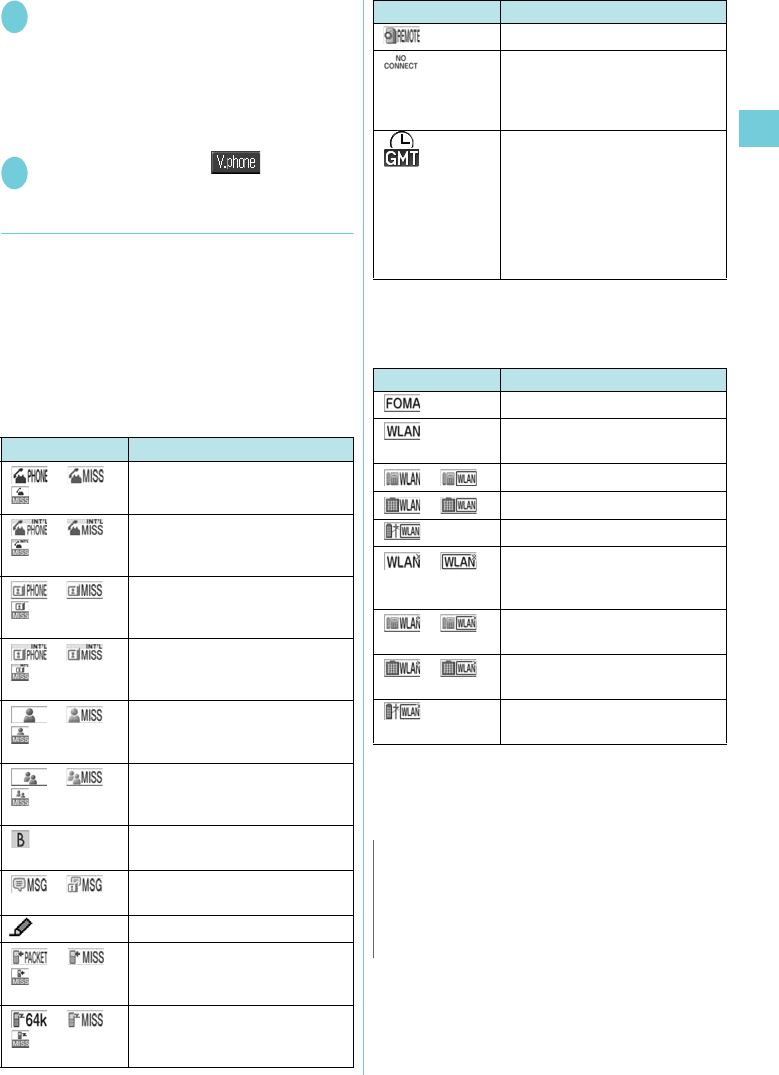
9
Continued on next page
Voice/Videophone Calls
2Highlight the Redial/Received calls
record entry
■To make a call after checking the details of
the Redial/Received calls record
XSelect the Redial/Received calls record entry
The “Redial (detail)” or “Received calls (detail)”
screen appears.
3r (voice call)/o ()
(videophone call)/@(PushTalk)
●Checking the number of missed calls
■To confirm only the missed calls from the
Received calls record
XiX“Own Data”X“Received calls”
Total number of received calls, the number of missed
calls and the number of unconfirmed missed calls
appear.
When you select “Missed calls”, only the missed calls
appears.
■Redial/Dialed calls/Received calls record icons
*1 : Some icons may appear differently between the screens
of detail and list.
*2 : Displayed only when the 2in1 is in Dual mode.
■Displayed Dialing mode/Receiving mode icons
*1 : Some icons may appear differently between the screens
of detail and list.
*2 : Icons displayed for WLAN (extension or outside)
receiving vary depending on the main device (SIP
server) settings.
Icon*1 Description
//
Incoming and outgoing/missed/
unconfirmed missed voice calls
//
Incoming and outgoing/missed/
unconfirmed missed international
voice calls
//
Incoming and outgoing/missed/
unconfirmed missed videophone
calls
//
Incoming and outgoing/missed/
unconfirmed missed international
videophone calls
//
Incoming and outgoing/missed/
unconfirmed missed PushTalk
(one-to-one) calls
//
Incoming and outgoing/missed/
unconfirmed missed PushTalk
(group) calls
※2Incoming and outgoing calls to B
mode for 2in1 setting
/Recorded voice record message/
videophone message
Received calls with Chaku-moji
//
Incoming and outgoing/missed/
unconfirmed missed packet
communication
//
Incoming and outgoing/missed/
unconfirmed missed 64K data
communication
Incoming remote observation calls
Incoming packet communication or
64K data communication that is
received without external device
connected
Incoming and outgoing calls when
you select any zones other than
“GMT+9” on the time zone
regardless of “Auto time adjust”
setting.
When “Summer time” is set to
“ON”, the World watch is displayed
reflecting the setting.
Icon*1 Description
FOMA dialing/receiving
WLAN dialing, WLAN (extension
or outside) receiving*2
/WLAN (extension) receiving*2
/WLAN (outside) receiving*2
WLAN (dedicated) receiving
/WLAN call that could not be dialed
or received (extension or
outside)*2
/
WLAN call (extension) that could not
be received
*2
/
WLAN call (outside) that could not be
received
*2
WLAN call (dedicated) that could
not be received
N
zIf you use 2in1, up to 30 records are stored for each
phone number. Also, when set to Dual mode, up to 30
Redial/Dialed calls/Received calls records for both
phone numbers and total of the 60 records are
displayed.
Icon*1 Description
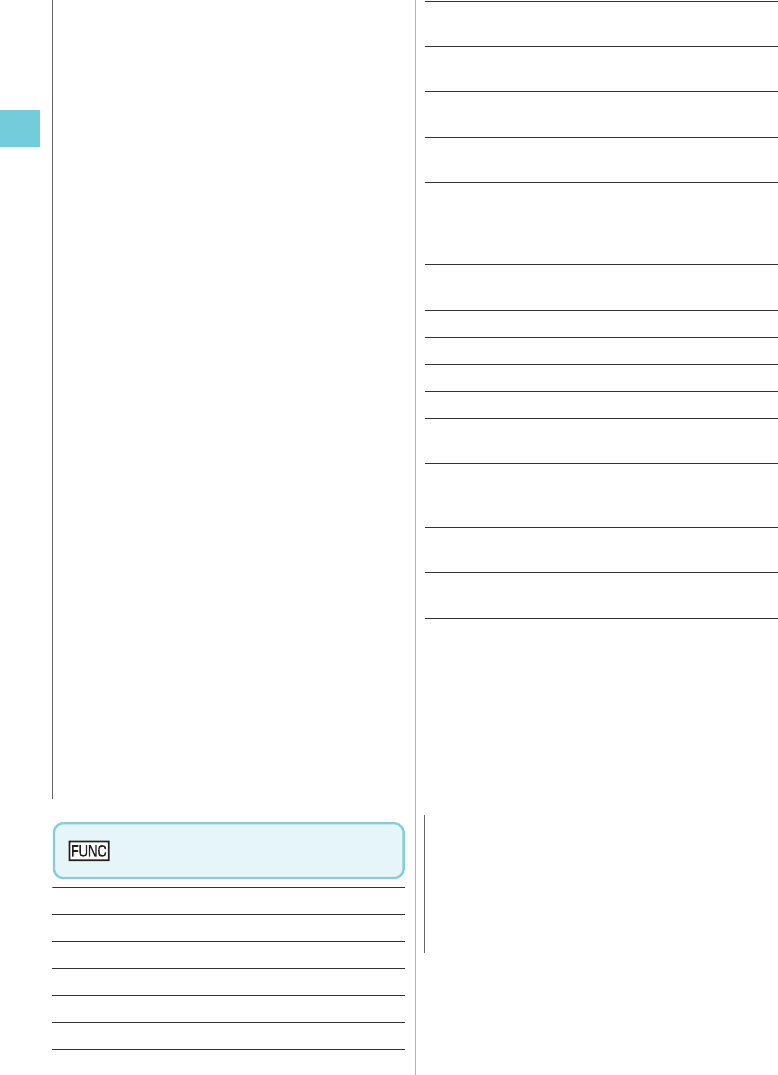
10
Voice/Videophone Calls
Redial/Dialed calls/Received
calls screen (p.8)
Select mode*1……Select “FOMA” or “WLAN” for dialing.
Notify Caller ID*2 →p.13
Prefix numbers*2*3 →p.15
Prefix*1*4……Enters a prefix for a WLAN voice call.
Chaku-moji*2*3 →p.11
Int’l call*2*3 →p.7
2in1/Multi Num.*2*3*5
Select PushTalk*6*7……“Redial Dialed calls and
Received calls record of PushTalk”
Ring time*8*9……Displays the missed call record entries
with the ringing times.
Disp. sending mode*9*10……Shows Redial/Dialed calls
sending mode icons.
Disp. receiv. mode*1*8*9……Shows Received calls
receiving mode icons.
Add to phonebook……Select “Add to phonebook”, “Add
to PushTalk”*7 or “Add to PushTalk Gr”*7 for the
destination. “Adding Phonebook Entries from the Redial,
Dialed Calls and Other Records”
Look-up phonebook*3……“Accessing the phonebook
from the Redial or Dialed Calls record”
Add desktop icon
Compose message*3*7
Compose SMS*3*7
Sent address*1*10……Displays the sent address list.
Received address*8……Displays the received address
list.
Select image*3……Selects the image used during a
videophone call from “My side”/“Chara-den”. Select
“Release settings” to cancel the setting.
Big font⇔Standard font*9……Switches the character
size of the displayed name.
Delete……Selects the deleting method from “Delete this”/
“Delete selected”/“Delete all”. “About multiple-choice”
*1 : This function is unavailable when 2in1 mode is in B
mode.
*2 : This function is available only for the detail screen.
*3 : Not available on the PushTalk (group) records screen.
*4 : Cannot be used on the Redial/Dialed calls list screen.
*5 : Available only when the 2in1 is in Dual mode.
*6 : Available on the PushTalk (group) records screen.
*7 : Available only when 2in1 is in A mode or Dual mode, and
selecting the record screen for the A mode.
*8 : Available only for the Received calls screen.
*9 : This function is available only for the list screen.
*10: Available only for the Redial/Dialed calls screen.
Redial/Dialed calls
zSetting “Restrict dialing” deletes all the Redial/Dialed
calls records. However, calls made after the setting
are recorded in Redial/Dialed calls.
zIf you make a call by selecting Multi number from the
function menu, the registered name and number of the
additional number are displayed under the phone
number in the Redial screen (detail)/Dialed calls
record screen (detail). If you make a call without using
the function menu, nothing is displayed even when
“Set Multi Number” is set to additional number.
zIf “HOST Effective set” is set to “OFF”, the maximum
number of items displayed in Redial may be lower
than 30. For example, the dialed record of phone
number (extension) “12345” and sent record of SIP
address “12345@XXX.com” are stored as separate
redials, but regarded as the same redial in display, and
the number of displayed items will be lower.
<Received calls>
zWhen “Missed calls display” in the “Ring time(sec.)” is
set to “Not display” and you receive a call of which ring
tone sounded for shorter time than the time set in the
“Set mute seconds”, the call is not displayed on the
Received calls record.
zIf the caller is using the dial-in number, a number
different from the dial-in number may be displayed.
zIf the caller’s phone number/SIP address is not
provided, the reason for the non-notification is
displayed in the Received calls record.
zIf the same phone number/SIP address is registered
in multiple phonebook entries with different names,
the name retrieved by the phonebook search in the
order of reading is displayed in the Received calls
record.
zWhen you have subscribed to Multi number and make
a call from the Received calls record screen, the
phone call is made from the number which received
the call regardless of the “Set Multi Number” setting.
zWhen you receive a call for additional number of Multi
number, the registered name of the additional number
are displayed under the phone number in the
Received calls record screen (detail).
N
N
zSelecting “Compose message” enables you to
compose a mail with a mail address specified as the
address when the mail address is stored in the
phonebook together with the phone number. When
multiple mail addresses are stored in the phonebook,
the first address is specified as the address.
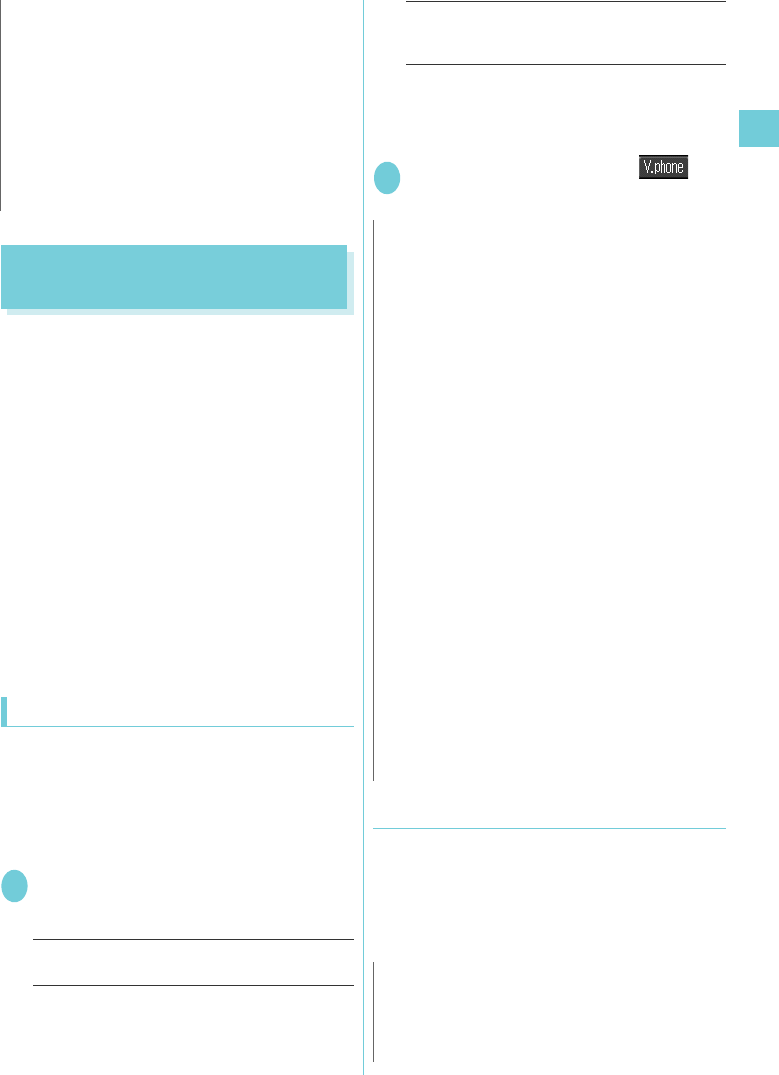
11
Voice/Videophone Calls
Using Chaku-moji
<Chaku-moji>
When making a FOMA voice call or videophone call,
you can send a message (Chaku-moji) to the other
party to show the summary of the call, etc.
beforehand.
z5 Chaku-moji messages are stored at the time of
purchase. You can change the pre-installed
messages.
zYou can include pictographs or face symbols in
Chaku-moji, and you can send a message of up to
10 characters including pictograph/symbol/double-
byte character/single-byte character.
zFor details on Chaku-moji and Chaku-moji-
compatible models, see the DoCoMo website or
refer to “Mobile Phone User’s Guide (Network
services)”.
zThe Chaku-moji is not compatible with PushTalk
calls.
zChaku-moji cannot be used for WLAN voice calls.
Dialing with Messages
You can add a message when making a FOMA voice
or videophone call from the “Enter phone number”
screen and the detail screen of the “Phonebook” or
“Redial”/“Dialed calls”/“Received calls”.
<Example: To make a FOMA voice call with message
from the enter phone number screen>
1Enter phone number screen (p.2)
X
u
(FUNC)
X
“Chaku-moji”
X
Select any
item:
Message……Enters a message. You can enter up
to 10 characters.
Select message……Selects from the stored Chaku-
moji. You can edit Chaku-moji by pressing o (Edit)
on the message selection screen.
Sent messages……Selects from the previously sent
message. You can edit the message by pressing o
(Edit) on the sent message screen.
■To delete the entered message (to make a
call without message)
Xu (FUNC)X“Chaku-moji”X“Create
message”XClear all the entered messages
2r (FOMA voice call)/o ()
(videophone call)
●When you receive a FOMA voice or
videophone call with Chaku-moji
The Chaku-moji appears on the ringing screen. The
Chaku-moji disappears when you answer the call.
zThe received Chaku-moji is displayed in 3D
animation.
zWhen the FOMA terminal is folded, the Chaku-moji
appears on the indicator display.
zSelecting “Delete all” from the Redial/Dialed calls
record deletes all the Redial and Dialed calls records.
Note that selecting “Delete this” or “Delete selected”
for the Redial record does not delete the entries of
Dialed calls record, and selecting “Delete this” or
“Delete selected” does not delete the entries of the
Redial record. Use the function menu of the Dialed
calls screen to delete the Dialed records and use the
function menu of the Redial screen to delete the
Redial record.
N
N
zSending Chaku-moji is charged. Receiving Chaku-
moji is not charged.
zYou can store up to 30 Chaku-moji in the sent
messages record*. When you send the same
message repeatedly, only the latest one is recorded.
When the entries exceed the maximum number,
entries are overwritten from the oldest entry.
*:When using 2in1, up to 30 Chaku-moji can be recorded
as a sent message history in each mode. In Dual
mode, both sent message histories are displayed by
30 Chaku-moji each, that is, 60 max.
zIf the receiver’s terminal is under conditions such as
followings, Chaku-moji cannot be sent. In this case, no
sending charges apply.
• The terminal is not compatible with Chaku-moji
(“Transmission failed” appears)
• Chaku-moji does not appear on the screen of the
receiver terminal because of the “MSG display
settings” on the receiver terminal (“Transmission
failed” appears)
• When Public mode (Driving mode) is set
• The ringing time for recording message is set to 0
second
• Out of FOMA range or powered off
zDepending on the signal status, sending result does
not appear on the sender terminal even when the
receiver terminal receives Chaku-moji. In this case,
sending charges apply.
zYou cannot send or receive Chaku-moji overseas.
N
zEven when you receive a call whose ring tone
sounded for shorter time than the time set in the “Set
mute seconds” of “Ring time(sec.)”, Chaku-moji is
displayed and recorded in the Received calls record.
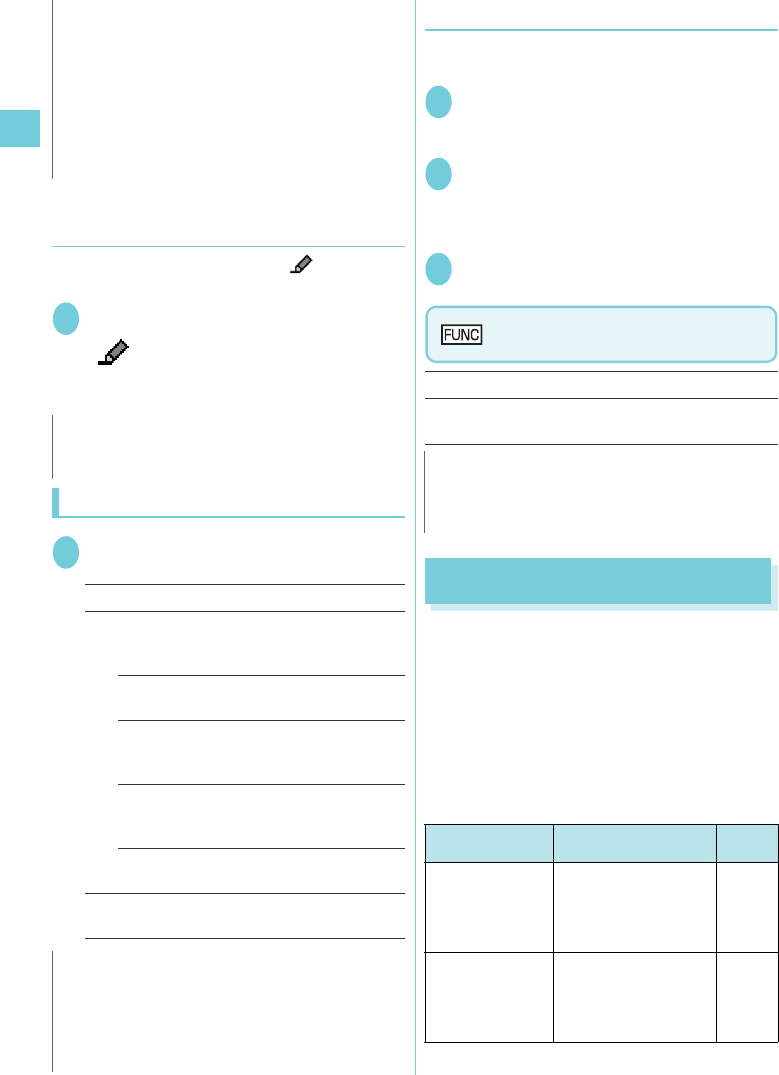
12
Voice/Videophone Calls
●Displaying Chaku-moji from the
Received calls record
When you receive Chaku-moji, the “ ” icon
appears on the Received calls record.
1On the standby screen
X
h
X
Select
the Received calls record entry with
“ ” displayed
The “Received calls (detail)” screen appears and
you can check the Chaku-moji message.
Editing and setting messages
1i
X
“Service”
X
“Chaku-moji”
X
Select
any item
Create message→p.12
MSG display settings……Sets the Chaku-moji
display setting when you receive a call with Chaku-
moji.
Display all messages……Displays all Chaku-
moji messages.
Only number in PH-book……Displays only
the Chaku-moji messages from senders stored
in the phonebook.
Calls with Caller ID……Displays only the
Chaku-moji messages from senders providing
the caller ID.
Hide all messages……Hides all Chaku-moji
messages.
3D message display……Sets whether to display
Chaku-moji in 3D animation.
●Storing Frequently Used Messages
zYou can store up to 30 Chaku-moji (including 5 pre-
installed).
1i
X
“Service”
X
“Chaku-
moji”
X
“Create message”
The “Create message list” screen appears.
2Highlight “<Not recorded>”
X
o (Edit)
■To change the details of a previously
stored message
XHighlight the item to changeXo (Edit)
3Enter a message
Create message list screen
(p.12)
Message……Enters a message.
Delete……Selects the deleting method from “Delete this”/
“Delete selected”/“Delete all”. “About multiple-choice”
Setting Caller ID Notification
If the other party’s phone supports caller ID display,
you can provide your phone number (caller ID) to
display on the other party’s phone (display) when you
make a FOMA voice or videophone call. Note that
your caller ID is important information and care
should be taken when providing it to others.
zThis function cannot be used for WLAN voice calls.
zWhen making a PushTalk call, the setting is
disabled even if you add the “186”/“184” prefix to
the other party’s phone number.
zSome pictographs are not displayed in 3D animation.
zDepending on the status of the sender or receiver,
Chaku-moji may not be displayed even if you receive a
call with Chaku-moji.
zWhen the Original lock is set to “Chaku-moji”, Chaku-
moji is not displayed even if you receive a call with
Chaku-moji. In this case, Chaku-moji is stored to the
Received calls record after releasing the lock.
N
zEven when you make a call using the Received calls
record, the Chaku-moji in the record is not sent.
N
z“MSG display settings” is also valid on the indicator
display.
zEven when “3D message display” is set to “ON”, the
message does not appear in 3D animation on the
indicator display,
N
N
zYou cannot delete the pre-installed messages. Even
when you change a pre-installed message and delete
it, it is restored to the default.
Function Description Refer
to
Notify Caller ID
(Setting at one
time)
Specifies whether other
parties are notified of
your caller ID whenever
you make a FOMA voice
call or videophone call.
Notify Caller ID
(Setting each time
you make a call)
Specifies whether other
parties are notified of
your caller ID whenever
you make a FOMA voice
call or videophone call.
p.13
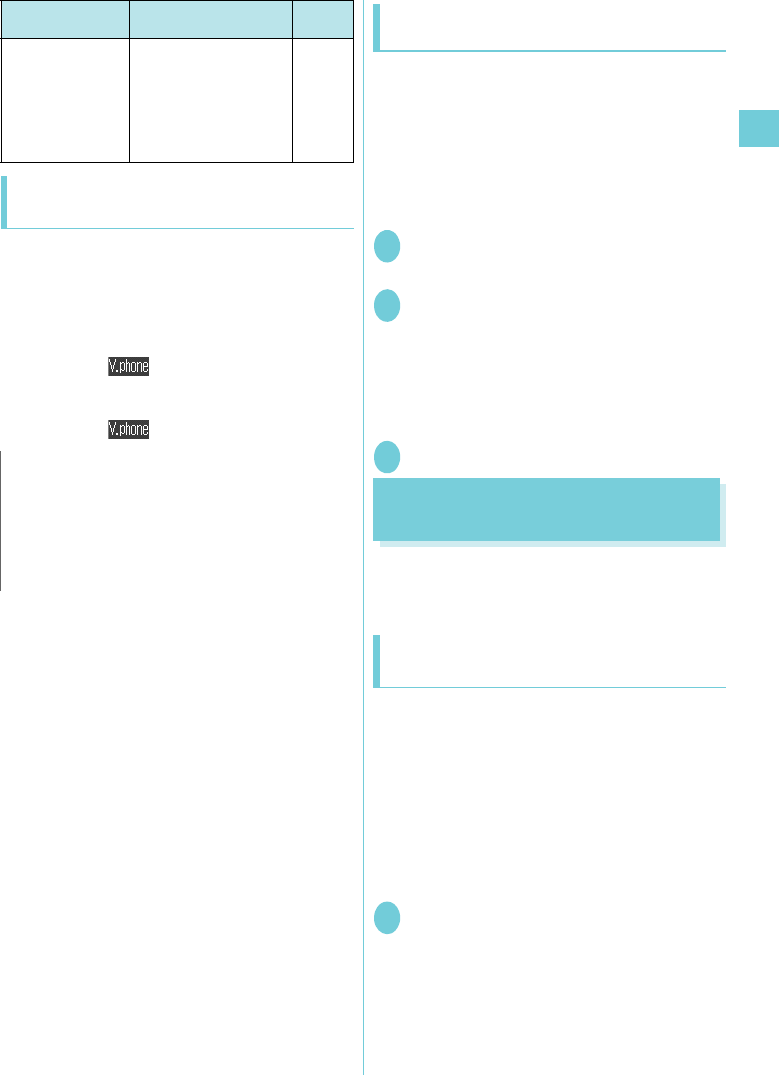
13
Continued on next page
Voice/Videophone Calls
Adding the “186”/“184” prefix to the
other party’s phone number
To provide your caller ID each time you make a
FOMA voice call or videophone call, add the “186”
prefix when you dial the phone number. To withhold
your caller ID, use the “184” prefix.
■To provide your phone number
186 - “The other party’s phone number” - r (FOMA
voice call)/o ( ) (videophone call)
■To withhold your phone number
184 - “The other party’s phone number” - r (FOMA
voice call)/o ( ) (videophone call)
Setting Caller ID Notification
<Caller ID Notification>
Select “OFF” or “ON” to specify whether you provide
the phone number to the other party.
zYou can use the Caller ID Notification function from
the “Enter phone number” screen and the detail
screens of “Phonebook”/“Received calls”/“Dialed
calls”/“Redial” screens.
<Example: To make a FOMA voice call from the Enter
phone number screen>
1Enter the phone number of the other
party
2u (FUNC)
X
“Notify Caller ID”
X
“OFF”
or “ON”
■To cancel the “OFF”/“ON” setting of
“Notify Caller ID”
X“Cancel prefix”
When “Cancel prefix” is selected, the “Caller ID
Notification” setting is applied.
3r
Sending Push Signals
<Pause dial>
By sending push signals from the FOMA terminal,
you can use services such as ticket ordering and
bank balance requests.
Storing dialing data as pause dial
record entries
You can store the dialing data used as push signals to
Pause dial beforehand. Inserting p (pause) into the
dialing data allows you to send data with a separation
where a pause lies.
zYou can store 1 dialing data, consisting of up to 128
characters.
zYou can enter numbers from 0 to 9, the # and *
symbols, and p (pause) for dialing data.
zYou cannot enter p (pause) in succession or at the
beginning of the dialing data.
1i
X
“Settings”
X
“Dialing”
X
“Pause
dial”
「The “Pause dial” screen appears.
■If there is dialing data already stored
The stored dialing data appears.
“186”/“184” Uses “186”/“184”
prefixes to specify
whether your caller ID is
provided or withheld
each time you make a
FOMA voice call or
videophone call.
p.13
N
zWhen making an international call, the setting is
disabled. Select “Notify Caller ID” from the function
menu.
zIf you make a FOMA voice call or videophone call with the
“186”/“184” prefix, the phone number including this prefix is
recorded in the Redial/Dialed calls.
Function Description Refer
to
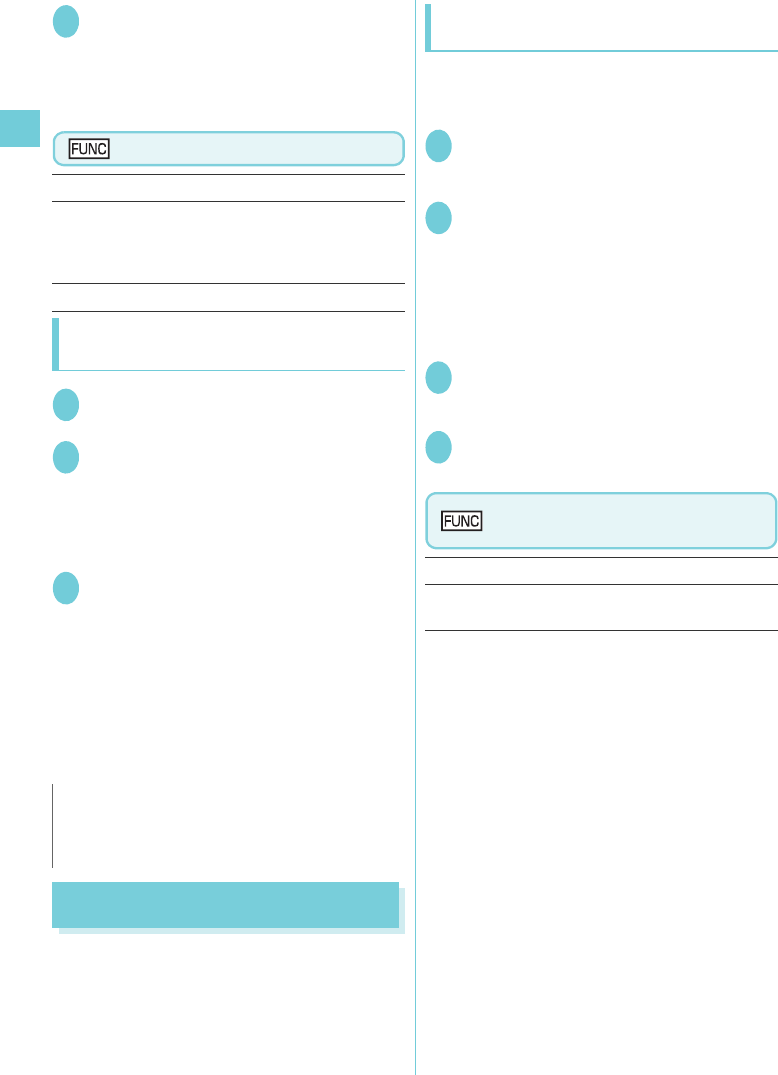
14
Voice/Videophone Calls
2o (Edit)
X
Enter the dialing data
Press 0 to 9, q and w to enter the
dialing data.
■To enter p (pause)
Xw (1 second or longer)
Pause dial screen (p.13)
Edit……Edits the dialing data.
Send pause dial……Enters the phone number/SIP
address of the other party and sends the dialing data.
Each time you press r, the dialing data up to p (pause)
is transmitted.
Delete……Deletes the stored dialing data.
Transmitting the dialing data as a
pause dial
1i
X
“Settings”
X
“Dialing”
X
“Pause
dial”
X
d (Send)
2Dial the phone number/SIP address of
the destination
X
r
The FOMA terminal calls the entered phone
number/SIP address and displays the dialing
data up to the first p (pause) while the dialed
phone is ringing. p (pause) is not displayed.
3r
Each time you press r, the dialing data up to
p (pause) is transmitted. Once the FOMA
terminal has finished sending the last number,
the in-call screen reappears.
■To transmit all the dialing data at once
Xj (for 1 second or longer)
X
“Send at one
time”
It may not be possible to send all the data at
once to some recipients.
Using the Prefix Function
You can store the prefix numbers such as IDD prefix
code (WORLD CALL = 009130-010) and 186/184 for
notifying/withholding your caller ID beforehand and
add these prefix numbers when you make calls.
Adding the Prefix Numbers
<Prefix setting>
zYou can store up to 7 prefix numbers.
zYou can enter numbers from 0 to 9 and the #, *
and + symbols.
1i
X
“Settings”
X
“Dialing”
X
“Prefix
setting”
The “Prefix setting” screen appears.
2Highlight “<Not recorded>”
X
o (Edit)
■To change the details of a previously
stored item
XHighlight an item to change
X
o (Edit)
■To check the details of a previously stored
item
XSelect the item to be checked
3Enter the name to be stored
You can enter up to 8 double-byte or 16 single-
byte characters.
4Enter the numbers (prefix)
You can enter up to 10 digits.
Prefix setting (p.14)/IDD Prefix
setting (p.8)
Edit……Edits the prefix number or IDD prefix code.
Delete this/Delete all……Deletes one or all prefixes or
international access codes.
N
zSome phones may be unable to receive push signals.
zA letter “p” contained in the SIP address is not
recognized as pause.
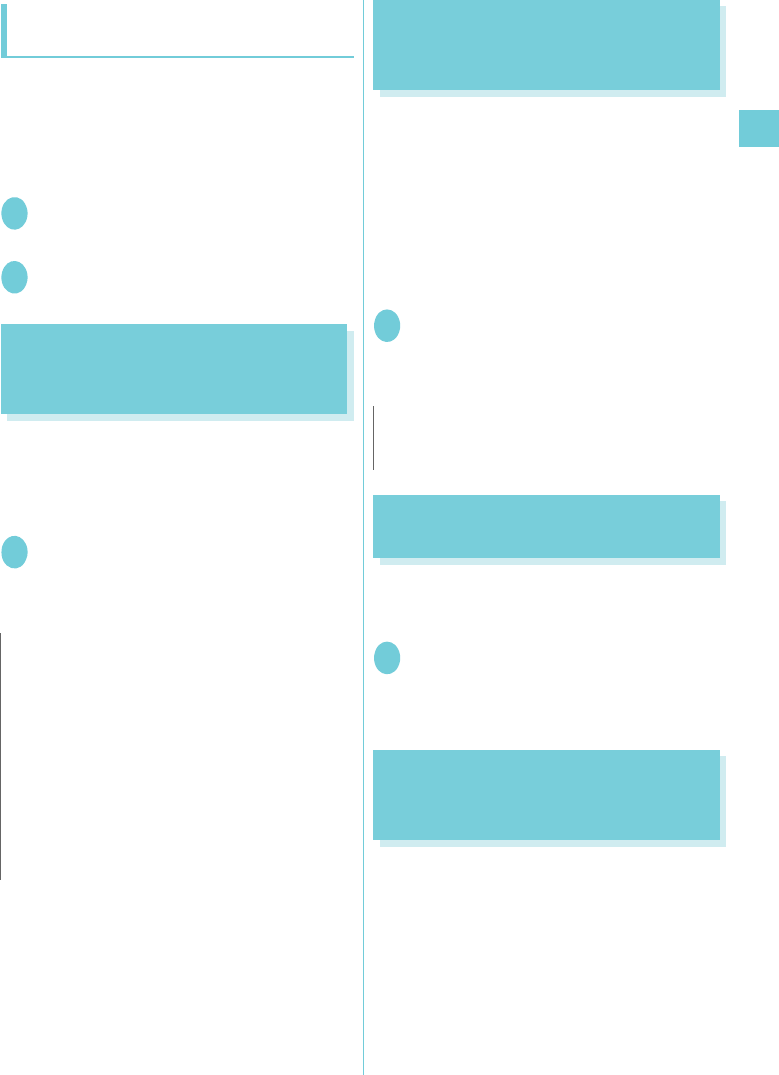
15
Continued on next page
Voice/Videophone Calls
Making a call with the Prefix numbers
<Prefix numbers>
zYou can add the prefix numbers from the “Enter
phone number” screen and the detail screens of
“Phonebook”/“Received calls”/“Dialed calls”/
“Redial” screens.
<Example: To make a voice call by adding prefix
numbers from the enter phone number screen>
1Enter the phone number of the other
party
2u (FUNC)
X
“Prefix numbers”
X
Select
the stored name
X
r
Setting Sub-addresses When
Making Calls
<Sub-address setting>
You can set “*” in the phone number as a separator
so that the numbers following “*” are recognized as a
sub-address. Sub-addresses are used in ISDN to
identify calls made from specific communications
devices and to select content in “V-live”.
1i
X
“Settings”
X
“Dialing”
X
“Sub-
address setting”
X
“ON”
■To disable the function
X“OFF”
Setting the Alarm Used for
Reconnection
<Reconnect signal>
When the signal quality deteriorates during a FOMA
voice/videophone or PushTalk call and the call drops
out, the FOMA terminal will automatically reconnect
the call if the signal quality quickly improves. Set the
type of alarm when a call is reconnected for this
function.
zThe interval for reconnection varies depending on
communication conditions or the signal quality. It
takes about 10 seconds.
zA WLAN voice call is not reconnected after ended.
1iX“Settings”X“Talk”XReconnect
signalXSelect an alarm tone
■To disable alarm tone
X“No tone”
Blocking Out Ambient
<Noise reduction>
This function suppresses ambient noise and makes it
easier for the other party in a voice, videophone or
PushTalk call to hear you.
1i
X
“Settings”
X
“Talk”
X
“Noise
reduction”
X
“ON”
■To disable the function
X“OFF”
Making Handsfree Calls in the
Car
<In-car hands-free>
You can make or receive FOMA voice calls with
handsfree compatible devices by connecting the
FOMA terminal to handsfree compatible devices such
as the In-Car Hands-Free Kit 01 (optional) or a car
navigation system.
For information on how to use the handsfree device,
refer to the manual provided with the device. The
FOMA In-Car Hands-Free Cable 01 (optional) is
required to use the In-Car Hands-Free Kit 01
(optional).
N
zIn the following cases, “*” does not function as a sub-
address separator.The entered number including “*”
is recognized as an ordinary phone number:
• When the “*” is entered at the beginning of a phone
number
• When “*” immediately follows “186”/“184” at the
beginning of a phone number
• When “*” immediately follows a number entered
using “Prefix numbers”
• When the phone number contains “*590#”/
“*591#”/“*592#”
• When making a WLAN voice call
N
zCall charges apply in the interval (up to about 10
seconds) for reconnection.
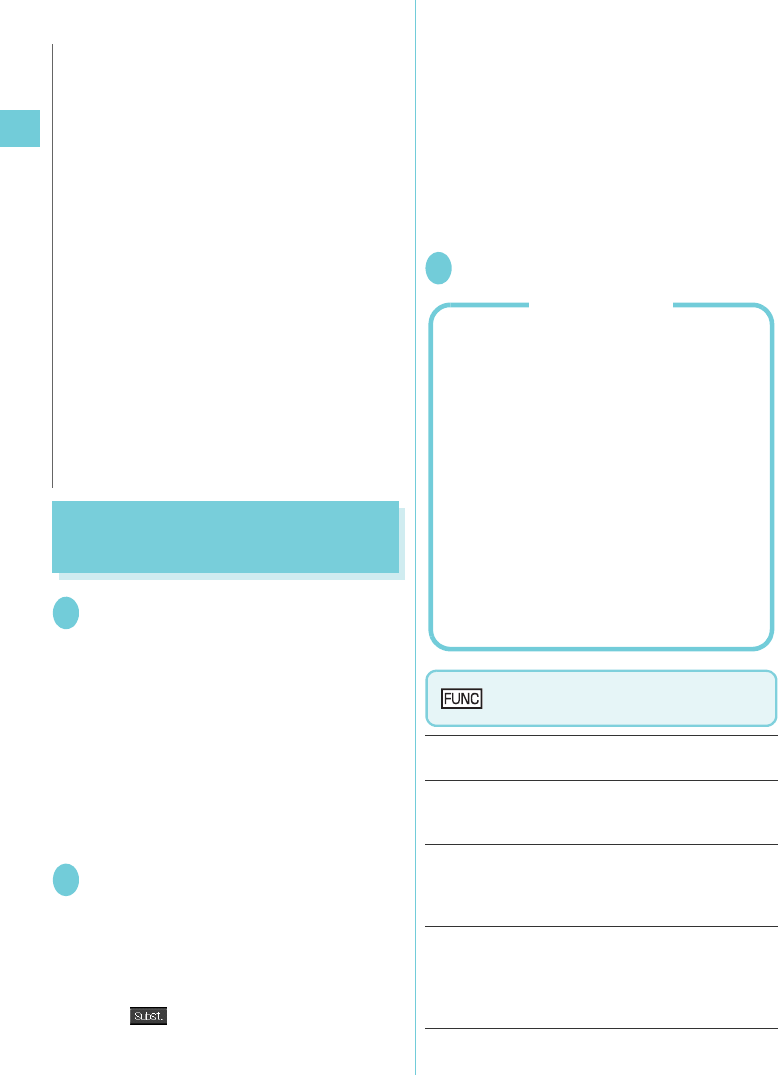
16
Voice/Videophone Calls
zIn-Car Hands-Free cannot be used for WLAN voice
calls.
Receiving FOMA Voice/
Videophone Calls
1When you receive a FOMA voice/
videophone call
The ring tone sounds and the incoming call lamp
flashes. The “Ringing” or “Videophone ringing”
screen appears.
■When you receive a call with Chaku-moji
The Chaku-moji appears on the ringing or
videophone ringing screen. You can check the
topic, etc. beforehand.→p.11
■To put a FOMA voice/videophone call on
hold while the FOMA terminal is ringing
“Holding the Ringing/Current Call” →p.19
2r
The “FOMA voice in-call” or “Videophone in-call”
screen appears.
When you receive a videophone call, you can
hear the other party’s voice from the speaker.
■To answer a videophone call with the
substitute image
Xd ()
■Operations during a videophone call
You can perform various operations such as
changing the camera image to the substitute
image, changing the front camera to rear
camera, muting the sound.→p.2
■When the other party switches a FOMA
voice/videophone call during a call
“When the Other Party Switches FOMA Voice/
Videophone Calls (Caller)”→p.17
■To put the current FOMA voice/
videophone call on hold
“Holding the Ringing/Current Call” →p.19
3To end the call, press y
Ringing screen/Videophone
ringing screen (p.16)
Call Rejection……Terminates the receiving call without
answering.
Call Forwarding……Forwards the call.The call is
forwarded regardless of the “Call Forwarding” setting
“Activate”/“Deactivate”.
Voice Mail……Connects the call to the voice mail service
center. The call is connected to the voice mail service
center regardless of the “Voice Mail” setting “Activate”/
“Deactivate”.
Change Display……Switches the display from additional
number 1 or 2 to the number from which the call is
forwarded. This can be selected when receiving multi
number call (for additional number 1 or 2) and the call is
forwarded at the same time.
N
zTo operate from the handsfree device, set the USB
mode to “Communication mode”.
zThe display and ring tones used for incoming calls and
mail are as specified in the FOMA terminal settings.
zWhen the handsfree device is set to emit the sound
from the hands-free device, the ring tone still sound
through the handsfree device even when the FOMA
terminal is set to Manner mode or the ring volume is
set to “Silent”.
zWhen the Public mode (Driving mode) is set,
operation for incoming calls and messages is as
specified in the “Public mode (Driving mode)” settings.
zWhen the Record message is set, operation for
incoming calls is as specified in the “Record message”
settings.
zWhen the handsfree device is set to emit the sound
from the FOMA terminal, operation when the FOMA
terminal is folded during a call is as specified in
“Setting when folded”. When the hands-free device is
set to emit sound from the handsfree device, folding
the FOMA terminal does not affect the call status
regardless of the “Setting when folded” setting.
Display while receiving a call
■When the other party’s phone number is
notified
The other party’s phone number appears on the
screen. When the caller is stored in the
phonebook, the name stored in the phonebook
appears.
zIf the same phone number is registered in
multiple phonebook entries with different
names, the first name retrieved by the
phonebook search in the order of reading
appears.
zIf the caller is stored as secret data, the name
or other information does not appear and only
the phone number appears.
zWhen you receive a call for additional number
of Multi number, the registered name of the
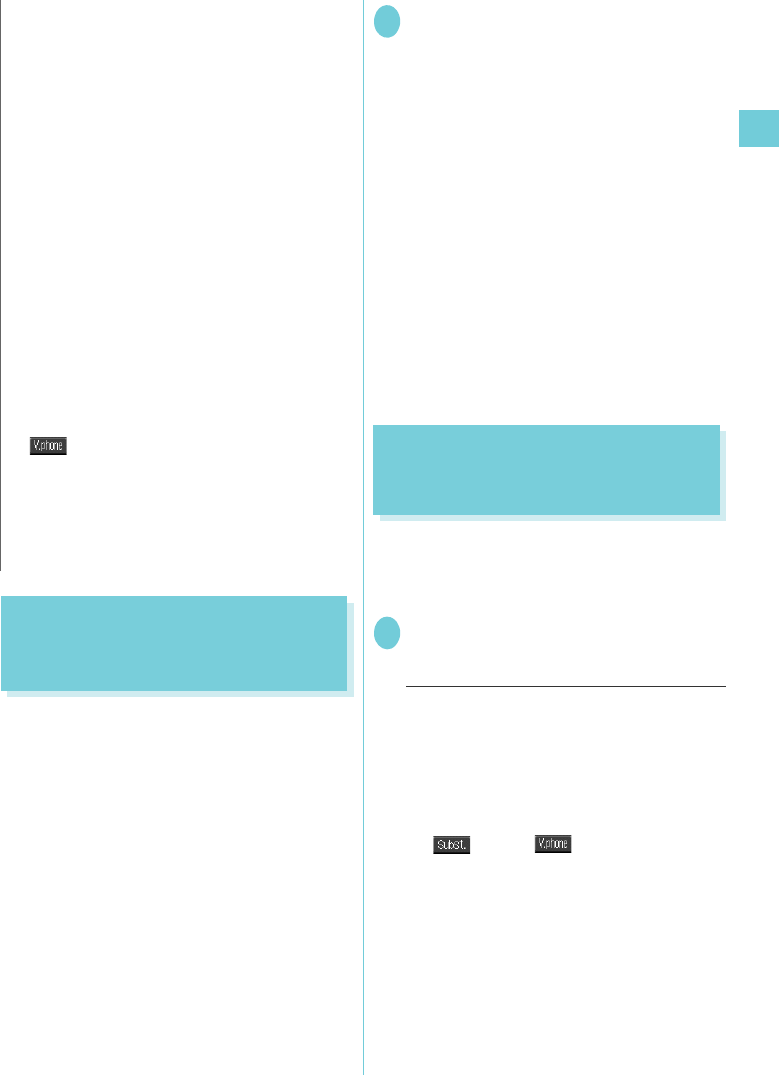
17
Continued on next page
Voice/Videophone Calls
When the Other Party
Switches FOMA Voice/
Videophone Calls (Caller)
When you receive a FOMA voice/videophone call, the
other party can switch the call between FOMA voice
call and videophone call.
zThe receiver cannot switch a voice call to a
videophone call.
zTo switch the call, the receiver needs to set “Ntfy
switch-mode” to notify the switch beforehand.→
p.29
zYou can use this function with the terminals
compatible with FOMA voice call/videophone call
switch.
<Example: When the other party switched a FOMA
voice call to a videophone call>
1FOMA voice in-call screen (p.2)XThe
other party switches to a videophone
callX“YES”
While switching, the screen which indicates that
the calls are being switched appears and the
voice guidance is played.
When the voice call is switched to the
videophone call, the camera image is sent to the
other party.
■To send substitute image to the caller
X“NO”
The specified substitute image is sent to the
caller.
■When a videophone call changes to a
FOMA voice call
XVideophone in-call screen (p.2)XThe other
party switches to a FOMA voice call
The videophone call is switched to a FOMA
voice call.
Using the Dial Keys to
Answer a Call
<Answer setting>
You can use this setting to turn off the ring tone or
answer the phone quickly when you receive a call.
This is useful when you receive a call in a situation
where the ring tone may disturb people around you.
1iX“Settings”X“Incoming
call”X“Answer setting”XSelect any
item
Any key answer……Valid for voice or PushTalk
calls.r, You can answer the call by pressing any
of the following keys: d (Answer), 0 to 9,
w, t, o, p,a ( マナー ), E and D, b, F
(C) and G (for voice calls only), and @ (for PushTalk
calls only)
* For videophone calls, you can answer the call
only by ordinary key operations (r, d
() or o ().
N
zIf you receive a call when using the view style, switch
the display to the standard type to answer the call.
zYou can receive a call using a flat-plug earphone/
microphone with switch (optional).
zIf you have subscribed to the Call waiting, Voice mail
or Call forwarding service, activate “Set in-call arrival”
and set “Incoming Call Mng” to “Answer”, you will hear
a short double-beep (“bibip”) when you receive a call
when you are already on a call.
• In case of the Voice mail or Call forwarding service,
you can answer the call by ending the current call.
• In case of the Call waiting service, you can answer a
FOMA voice call by putting the current call on hold
and you can answer a videophone call by ending the
current call.
<Voice call>
zYou can set the incoming call management from a
caller who is not stored in the phonebook.
zYou can set the incoming call restriction for each
phone number stored in the phonebook.
<Videophone>
zYou can also answer the call by pressing o
().
zDigital communication charges are still applied to the
caller when the substitute image is displayed during a
videophone call.
zIt may take a few seconds to switch from a camera
image to a substitute image (Chara-den) depending
on the Chara-den.
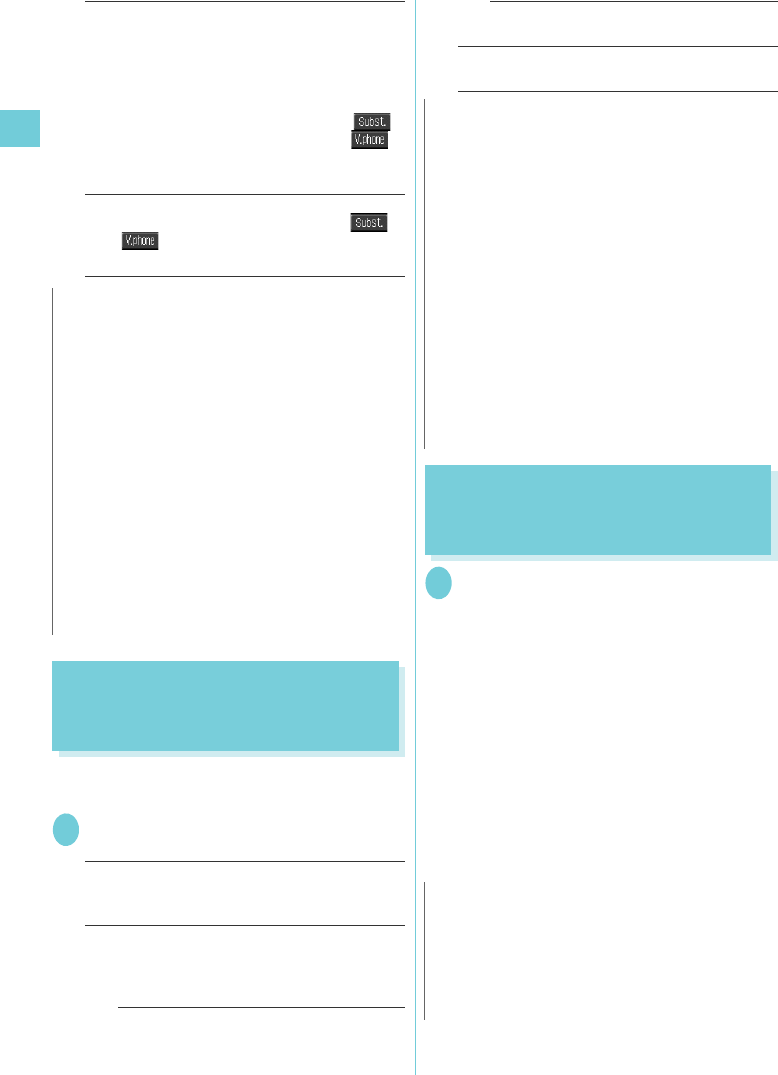
18
Voice/Videophone Calls
Quick silent……Pressing any of the following keys
or opening the FOMA terminal stops the incoming
call reaction while the caller continues to hear the
ring tone: 0 to 9, w, t, b, p, a (マ
ナー ), F (C), G, D or o (for voice calls and
PushTalk calls only)
To answer the call, press r, d (Answer/ ),
E (for unfolded FOMA terminal only), o ()
(for videophone calls only), @ (for PushTalk calls
only).
OFF……You can answer the call only with the
ordinary key operations: r, d (Answer/ ),
o ( ) (for videophone calls only), @ (for
PushTalk calls only)
Ending/Holding Calls with the
FOMA Terminal Folded
<Setting when folded>
You can set how your FOMA terminal operates when
it is folded during a voice or videophone call.
1iX“Settings”X“Talk”X“Setting
when folded”XSelect any item
No tone……Mutes the sound. For videophone calls,
the “Substitute image” is sent to the other party. The
other party does not hear the hold tone.
Tone on……Puts a call on hold (holding). When the
FOMA terminal is folded, the other party hears the
hold tone. For videophone calls, the “Substitute
image” is sent to the other party.
Speaker ON……The hold tone is sent to the
other party and also plays through the speaker.
Speaker OFF……Only the other party hears
the hold tone.
End the call……Ends the call. It is the same
operation as pressing y.
Adjusting the Earpiece
Volume
<Volume>
1On the standby screen
X
c (1 second
or longer)
X
Adjust the volume with c
Pressing c (1 second or longer) displays the
earpiece volume screen. If no operation is
conducted for 2 seconds or longer when the
earpiece volume screen is displayed, the
earpiece volume screen is expired.
You can adjust the volume in 6 steps from “Level
1” (quietest) to “Level 6” (loudest).
■To adjust the earpiece volume during a
voice call
Xa (マナー )/s (L)
■To adjust the earpiece volume during a
videophone call
Xc or a (マナー )/s (L)
N
zEven when “Quick silent” is set, the “Any key answer”
function is used in Manner mode.
zEven when “Any key answer” or “Quick silent” is set,
pressing and holding 5 (Emergency mode ON/
OFF) or 8 (Privacy angle ON/OFF) for 1 second or
longer disables “Any key answer” or “Quick silent”
function.
zWhen a flat-plug earphone/microphone with switch
(optional) is connected to the FOMA terminal, you can
answer calls by pressing the switch on the flat-plug
earphone/microphone with switch regardless of the
“Any key answer” setting.
zWhen “Any key answer” is set and the FOMA terminal
is folded, press a ( マナー), F (C), G, D to hold on the
voice call. If Setting when folded is set to “Tone on”,
the hold tone sounds. However, if “No tone” or “End
the call” is set, no hold tone sounds.
N
zWhen Manner mode is set, no sound is played
through the speaker even if “Speaker ON” is set.
z
When a flat-plug earphone/microphone with switch
(optional) is connected, this function is disabled and
even folding the
FOMA terminal
does not change the
call status. However, during a videophone call using the
camera image, folding the FOMA terminal switches to
the substitute image.
zEven if the “Tone on” setting is selected, folding the
FOMA terminal activates the “No tone” setting if “Call
Waiting” is switched on.
zThis function is disabled during a PushTalk call. The
“Setting when folded” under “PushTalk setting” is
applied.
zIf t is pressed to hold then the FOMA terminal is
folded during a WLAN voice call, the “Tone on” setting
will be disabled.
N
zDuring a voice call, you can adjust the volume with c
(1 second or longer) as in standby mode.
zIf you adjust the volume during a call, the adjusted
setting is retained after you end the call.
zYou can also adjust the volume during a PushTalk call
or handsfree call.

19
Continued on next page
Voice/Videophone Calls
Adjusting the Volume of Ring
Tone
<Ring volume>
You can adjust the volume of the ring tone for a
incoming call, mail, chat mail or MessageR/F, instant
message or presence report in 6 steps for each type
of call. You can also set to silent or to gradually get
louder.
1iX“Settings”X“Incoming
call”X“Ring volume”XSelect the item
of which you want to adjust the volume
Select “FOMA Phone” to adjust the ring tone
volume for FOMA voice calls and 64K data
communication.
Select “Mail” to adjust the ring tone volume for i-
mode mail, area mail, SMS or packet
communication.
2Use c to adjust the ring volume
X
d
(Set)
■To raise the volume gradually
XPress f in “Level 6”
When set to “Step”, the ring volume becomes
louder and louder from silent, “Level 1” to “Level
6” in every 3 seconds.
■To set to silent
XPress g in “Level 1”
An icon appears in the standby screen to
confirm that “Silent” ring tone is set.
:“Silent” set for one or more of “FOMA
Phone”, “WLAN Phone”, “WLAN Phone
(outside)”, “WLAN Pone (external)”, “WLAN
Phone (dedicated)”, “Videophone” and
“PushTalk”
: “Silent” set for one or more of “Mail”, “Chat
Mail”, “MessageR” and “MessageF”
: “Silent” set for both “ ” and “ ”
Holding the Ringing/Current
Call
<On hold/Holding>
<Example: To put the ringing call on hold>
1While ringing
X
y
The FOMA terminal makes three rapid beeps
and puts the call on hold.
The caller hears a message saying that you
cannot answer at the moment and the call is
held without hanging up.
■To put the current call on hold
XDuring a callXt
■To end the call during answer hold/
holding
Xy
■If the other party ends the call during
answer hold/holding
The call ends.
2Press r to resume the call
You can also use t to cancel holding when
you put the current call on hold.
Setting the hold tone <Set hold tone>
You can set the guidance messages to the other
party during on hold.
1i
X
“Settings”
X
“Talk”
X
“Set hold
tone”
X
Select any item
On hold tone……Sets the message played during
the answer hold.
Tone 1……The following message is played in
Japanese: “I can’t answer the phone just now.
Please wait for a few minutes or call again
later.”
Tone 2……The following message is played in
Japanese: “I can’t answer the phone just now.
Please call again later.”
N
zThe ring volume setting specified for “FOMA Phone” in
this function is also applied to the “Select ring tone”
setting for a voice call, the alarm tones for “Schedule”
and “To Do list”.
N
zCall charges apply while putting the ringing call or
current call on hold.
zIf you have subscribed to “Voice Mail” or “Call
Forwarding” service, selecting “Voice Mail” or “Call
Forwarding” from the function menu when you receive
a call either forwards the call to the voice mail service
or forwarding number.
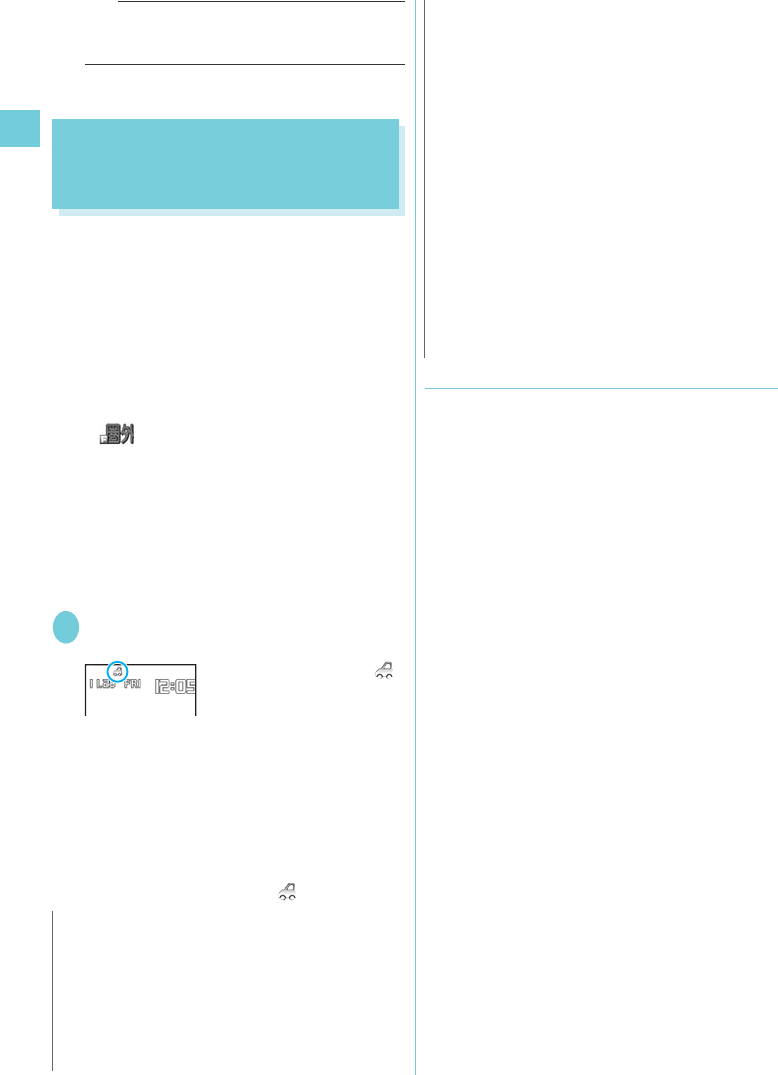
20
Voice/Videophone Calls
Voice announce 1/Voice announce 2*……
The message recorded using “Voice
announce” is played.
*: Not displayed if no Voice announce message has
been recorded.
Using the Public Mode
(Driving Mode)
<Public mode (Driving mode)>
The Public mode is an automatic answering service
provided to keep manner in public circumstances.
During Public mode, a caller hears a message that
you cannot answer the call because you are driving or
you are in the place you have to refrain from calling
(on the train or bus, in the theater, etc.), then the call
ends.
zPublic mode can only be set/released from the
standby screen. (It can also be set/released when
the “ ” icon is displayed.)
zYou can still make calls when the FOMA terminal is
in Public mode.
zThis function is not available during data
communication.
zWhen you receive a call of “User unset” while
Caller ID request is set to “Activate”, caller ID
request message is announced. (The Public mode
message is not announced.)
1On the standby screenXw (for 1
second or longer)
Public mode is set and “ ”
appears.
When you receive a call, the
caller hears the message “I
can’t answer the call
because I am driving or I
have to refrain from calling
now. Please call back later.”
■To release the Public mode (Driving mode)
XOn the standby screenXw (for 1 second or
longer)
Public mode is canceled and “ ” disappears.
●When Public mode (Driving mode) is set
The FOMA terminal does not ring when you receive a
voice, videophone or PushTalk call. Calls are logged in
the “Received calls” record as “Missed calls” record,
and the “Missed call” desktop icon appears on the
standby screen.
zA caller making a FOMA voice call hears a
message that you cannot answer the call because
you are driving or you are in the place you have to
refrain from using mobile phones, then the call
ends.
zA caller making a videophone call sees the Public
mode video message on his or her display, then the
call ends.
zThe FOMA terminal does not answer the PushTalk
call when receiving. “Connection failed” appears on
the display of the caller’s terminal. If the number of
call members is 3 or more, the members are
notified that you are driving.
zThe FOMA terminal does not answer a WLAN
voice call when receiving. The WLAN voice caller
does not hear the announcement, and the call is
disconnected.
zTable 1 (p.22) shows incoming operations when
Public mode (Driving mode) and network services
are set simultaneously:
zWhen you receive a mail, the ring tone does not
sound and the “New mail” desktop icon appears on
the standby screen.
zWhen you receive an instant message, the ring
tone does not sound and the “IM” desktop icon
appears on the standby screen.
zWhen you receive a presence report, the ring tone
does not sound and the “Report” desktop icon
appears on the standby screen.
N
zIf “Record message” is set to “ON”, Public mode takes
priority and the “Record message” setting is disabled.
zThe Public mode setting takes priority when Manner
mode is set at the same time.
zIf you make a FOMA voice call to an emergency
number (110, 119 or 118) while Public mode is set,
Public mode is released.
zThe following tones do not sound in Public mode:
• Ring tones for voice phone/videophone call/
PushTalk
• Ring tone of mail
• Ring tone for MessageR/F
• Ring tone of chat mail
• Instant message ring tone
• Presence report ring tone
•Alarm
• Alarm tone of the Schedule
• Alarm tone of the To Do list
• Alarm tone for Notify cost limit
• Low-voltage alarm tone
• Charge sound
• Software tone for i-αppli
• Ring tone for Packet communication/64K data
communication
• Search request alarm tone for GPS function
N
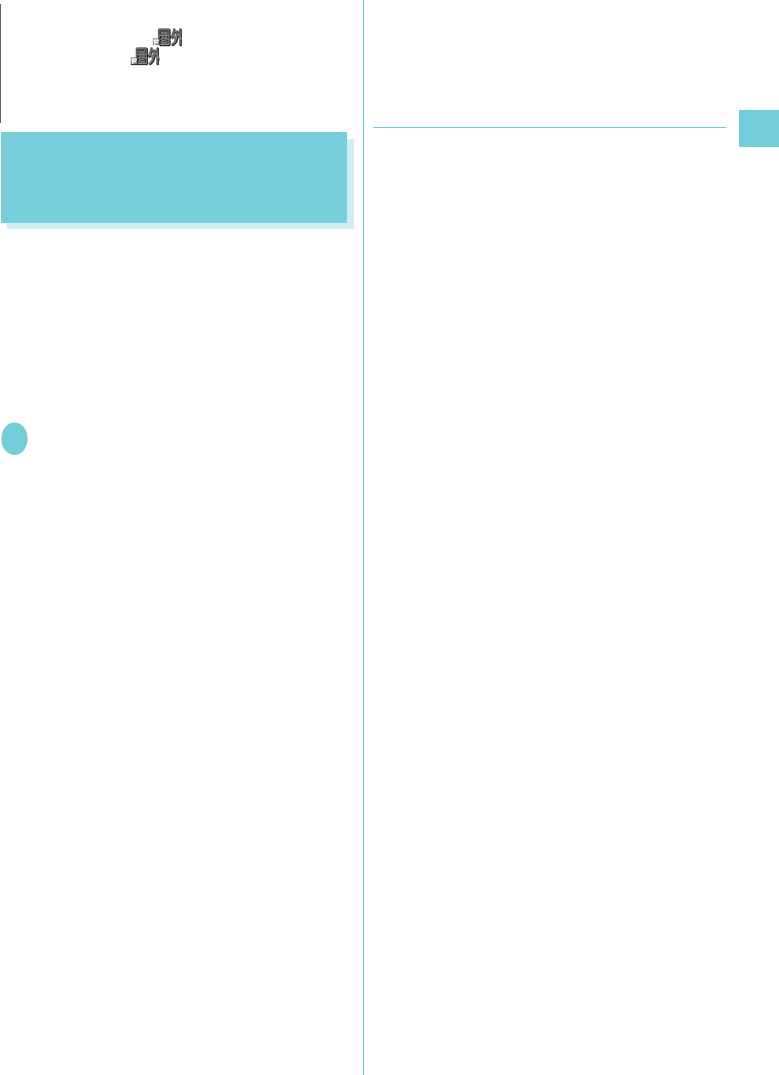
21
Voice/Videophone Calls
Using the Public Mode (Power
OFF)
<Public mode (Power OFF)>
The Public mode (Power OFF) is an automatic
answering service provided to keep manner in public
circumstances. During Public mode (Power OFF), a
caller who made a call while the FOMA terminal is
turned off hears a message that you cannot answer
the call because you are in the place you have to turn
off the mobile phone (in the hospital, on the airplane,
around the priority seat on the train, etc.), then the
call ends.
1On the standby
screen
X
w25251
X
r
Public mode (Power OFF) is set. (Nothing
changes on the standby screen.)
When you receive a call after setting Public
mode (Power OFF) and turning off the FOMA
terminal, the caller hears the message “The
person you are calling is in an area where cell
phone should not be used. Please call back
later.”
■To cancel the Public mode (Power OFF)
XOn the standby
screenXw25250Xr
Public mode (Power OFF) is canceled.
■To check Public mode (Power OFF) setting
XOn the standby
screenXw25259Xr
You can check Public mode (Power OFF)
setting.
●When Public mode (Power OFF) is set
The setting is valid until “*25250” is dialed to
released the Public mode (Power OFF). The setting is
not canceled only by turning on the FOMA terminal.
The Public mode (Power OFF) message is
announced even when you are in an out-of-service
area or where the reception is very poor.
zA caller making a voice call hears a message that
you cannot answer the call because you are in the
place you have to turn off the mobile phone, then
the call ends.
zA caller making a videophone call sees the Public
mode (Power OFF) video message on his or her
display, then the call ends.
zThe FOMA terminal does not answer the PushTalk
call when receiving. “Connection failed” appears on
the display of the caller’s terminal. If the number of
call members is 3 or more, the members are
notified that you are disconnecting.
zTable 1 shows incoming operations when Public
mode (Power OFF) and network services are set
simultaneously:Shown in p.22.
N
zIf the power is off or “ ” is displayed in the screen,
the message for “ ” is announced instead of the
Public mode message even when Public mode is set.
However, in case of PushTalk calls, a “Disconnected”
response is sent to the members.
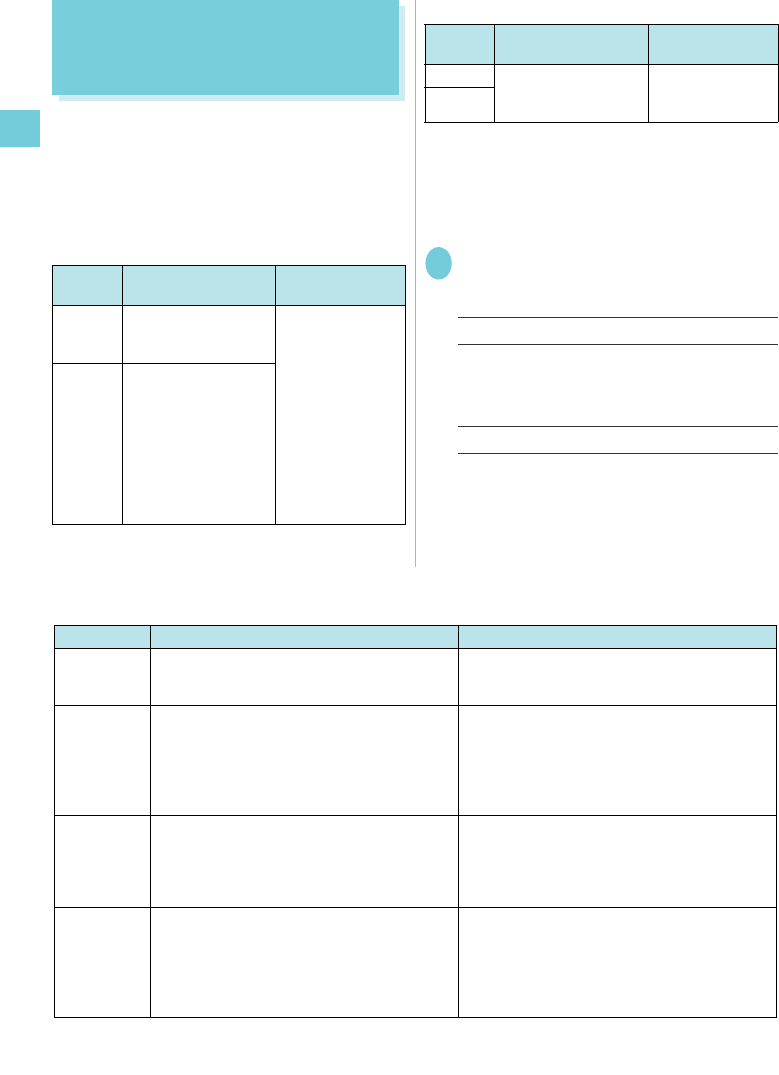
22
Voice/Videophone Calls
Setting the Notification
Method for Missed Calls
Notification tone
<Info notice setting>
You can set the notification method when checking a
missed call, new mail (i-mode mail, area mail and
SMS) or new instant message using E with the
FOMA terminal is folded.
zThe setting items and the checking operations by
pressing E are as follows:
■When there is a missed call, new mail, etc.
■When there is no missed call, new mail, etc.
*1 : The FOMA terminal vibrates when “FOMA Phone” in
“Vibrator” is set to other than “OFF”.
*2 : If the flashing color is set to “Gradation” in the
“Illumination” settings, the incoming call lamp flashes in
“Color 5” for missed calls, “Color 1” for new mails, “Color
3” for new chat mails and “Color 7” for new instant
messages.
1iX“Settings”X“Incoming
call”X“Info notice setting”XSelect any
item
ON……Reports with electronic tone.
ON*……Reports with electronic tone. Select ON or
OFF to read out the sender stored in the phonebook
when a message is received or voice memo is
recorded.
OFF……Not read out.
*: The announcement “This is from XX” to read out the
message is performed even when name
announcement is set to “OFF”. Reading out mail
message
Setting Sound and
vibration*1 Illumination
ON Notifies you of double
bibip sounds “Bibip,
bibip”.
Lights up for about
8 seconds in the
color set in
“Illumination”.
When there are
both missed calls
and new mails,
etc., the incoming
call lamp flashes in
the respective
color with a period
of 1 second*2.
ON You will hear the
sound “PiPi” and the
messages “New Chat
mail”, “New mail”,
“Missed call”, “New
instant message”,
“Record message”
and “Voice mail” in
order (Voice monitor).
[Table 1] Handling of received calls when network services and Public mode (Driving mode/
Power OFF) are set
*1 : In Public mode (Driving mode), the service targets FOMA voice calls only.
*2 : If the ring time is set to 0 second, the Public mode message is not announced and the “Voice Mail Service” or “Call
Forwarding Service” is applied. In addition, they are not recorded in the “Received calls” record and “Missed call”
Service When a voice call is received*1 When a videophone call is received
Voice Mail
service
• Connects to the Voice mail service center after
announcing the Public mode message.*2
• Connects to the Voice mail service center
without showing the Public mode video
message.
Call
Forwarding
Service
• Transfers the call to the forwarding number
after announcing the Public mode message.*2
• The Public mode message is announced or
not depending on the setting of the call
forwarding service.
• Transfers the videophone call to the forwarding
number without showing the Public mode video
message.
• The connection is not established when the
videophone for the forwarding number is not
compatible with 3G-324M.
Nuisance
Call Blk
• Ends the call after showing the message that
the connection could not be established for the
barred callers.
• Ends the call after announcing the Public
mode message for other callers.
• Ends the call after showing the video message
that the connection could not be established for
the barred callers.
• Ends the call after showing the Public mode
video message for other callers.
Caller ID
Request
• Ends the call after announcing the caller ID
request message for the callers who do not
provide the caller ID.
• Ends the call after announcing the Public
mode message for the callers who provide the
caller ID.
• Ends the call after showing the caller ID request
video message for the callers who do not
provide the caller ID.
• Ends the call after showing the Public mode
video message for the callers who provide the
caller ID.
Setting Sound and
vibration*1 Illumination
ON Notifies you of triple
pip sounds “pip, pip,
pip”.
Flashes for about
5 seconds in the
“Color 12”.
ON
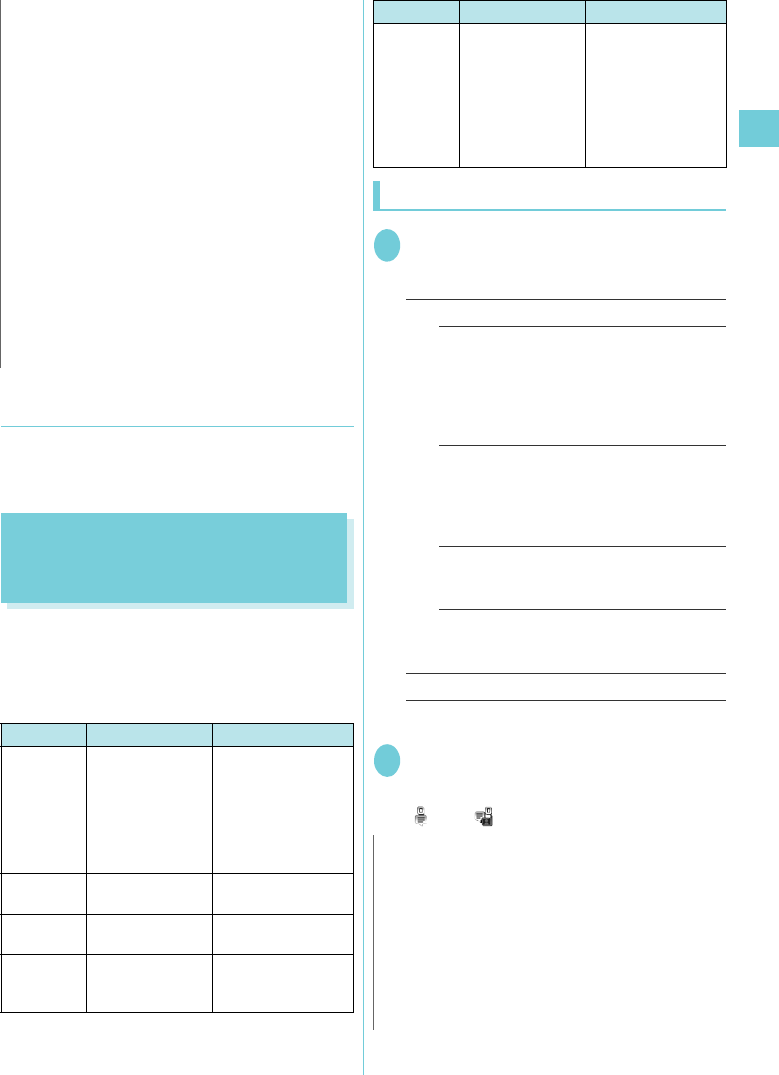
23
Voice/Videophone Calls
●Having the FOMA terminal read out the
current time
When set to “ボイス” (voice), the FOMA terminal
reads out the current time by pressing s (L) while it
is folded (Voice clock).
Having the Caller Leave a
Message
<Record message>
When you cannot answer a voice or videophone call,
this function allows you to record a message from the
caller on your FOMA terminal.
zThe difference between Record message and
Voice mail is as follows.
Setting Record message
1i
X
“Settings”
X
“Incoming
call”
X
“Record message”
X
Select any
item
ON……Select the desired type of answer message.
Japanese 1……“ただいま電話に出ることがで
きません。ピーッという発信音の後に20秒
以内でお名前とご用件をお話しください。” (I
can’t answer the phone just now. Please leave
your name and a short message within 20
seconds after the beep. Thank you.)
Japanese 2……“せっかく電話をもらったけ
ど、いま出られません。ピーッという発信音
の後にメッセージを入れてね。” (Sorry, but I
can’t take your call just now. Please leave a
message after the beep. Thank you.)
English……Plays the English message: “I
can’t take your call now. Please leave the
message. Thank you.”
Voice announce 1/Voice announce 2*……
The message recorded using “Voice
announce” is played.
OFF……Cancels the “Record message” setting.
*: Not displayed if no Voice announce message has
been recorded.
2Enter the ringing time (000 to 120
seconds in 3 digits)
The record message is automatically set and
“ ” and “ ” appear on the standby screen.
N
zThis function alerts you using a “YES” indication when
the “Missed call”, “New mail”, “Chat mail”, etc. desktop
icon is displayed on the standby screen.
zYou cannot use E to check for missed calls or new
mail in the following cases:
• When Side key guard is set to “ON”
• When playing music with the Music Player/
Music&Video Channel
zThe volume set in the “FOMA Phone” in the “Ring
volume” setting is used (if set to “Silent” or “Step”, the
volume is set to “Level 2”).
zOpening the FOMA terminal during the notification
stops the notification.
zIf the reading of caller’s name is not stored in the
phonebook or the name stored in the phonebook is
not displayed, the caller’s name is not read out even if
“ON” is set under “ボイス” (voice) in Japanese
language mode.
Item Record message Voice Mail service
Recording
time/
number of
messages
• Voice call: Up to
20 seconds, 5
messages
• Videophone call:
Up to 20
seconds, 2
messages
• Voice call: Up to 3
minutes, 20
messages
• Videophone call:
Up to 3 minutes,
20 messages
Retention
period
No limit Up to 72 hours
Where to
store
FOMA terminal Voice Mail Service
Center
Condition
for
playback
Inside and outside
the service area
Only in FOMA range
Condition
for
recording
• Recordable
when receiving
phone is turned
on inside the
service area
• Setting Record
message to
“ON”
• Recordable even if
the receiving
phone is turned off
inside/outside the
service area
• Activating the
Voice Mail Service
N
zWhen “Voice announce 1” or “Voice announce 2” is
deleted when the answer message is set to “Voice
announce 1” or “Voice announce 2”, the answer
message is set to “Japanese 1”.
zTo give priority to “Record message” function when
“Voice Mail”, “Call Forwarding” and “Record message”
are set at the same time, set the ringing time of
Record message shorter than that of Voice mail and
Call forwarding.
Item Record message Voice Mail service
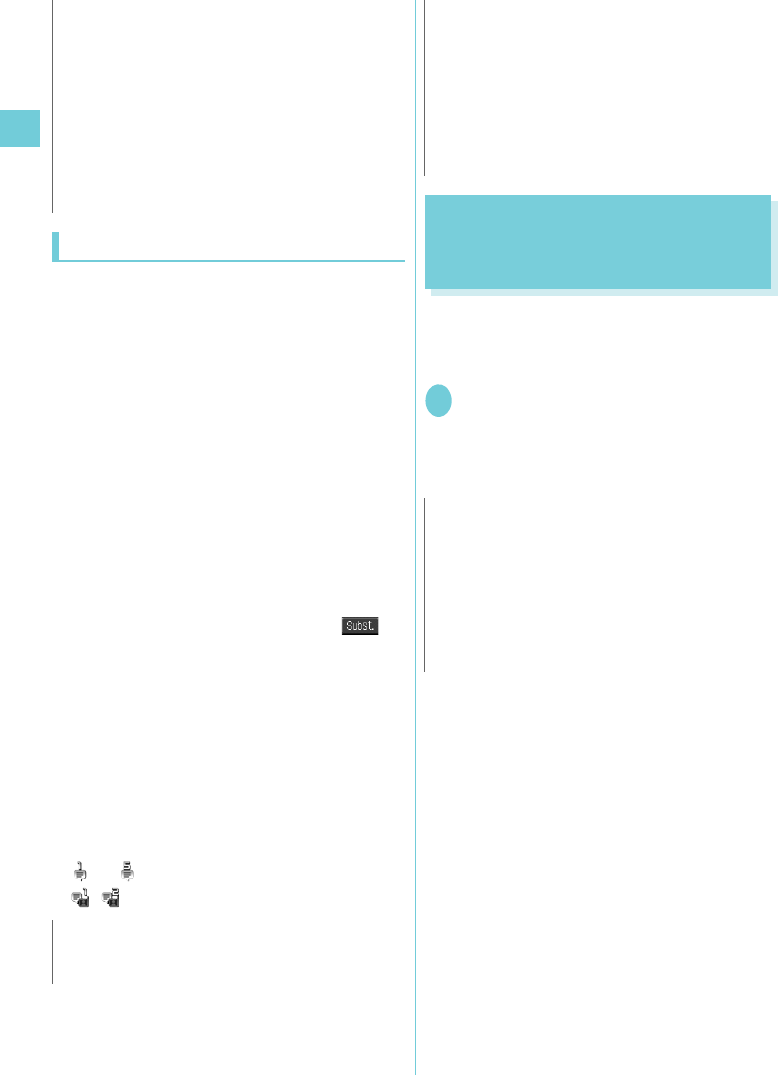
24
Voice/Videophone Calls
When setting Record message
The record message activates when a call arrives
and the set time is elapsed.
zTo the caller of a voice call, the answer message is
played and the recording starts.
zTo the caller of a videophone call, the “伝言メモ準
備中 Preparing” image is sent and the answer
message is played, then the “伝言メモ録画中
Recording” image is sent and the recording starts.
■When message recording starts
zThe recording screen appears. The caller’s voice
can be heard through the FOMA terminal earpiece
during message recording.
■To answer the voice call while recording
Xr
■To answer the videophone call while
recording
Xr to answer with the
camera image or d () to
answer with the substitute
image
■When message recording ends
zThe original screen reappears and the “Missed
call” desktop icon and “Record message” desktop
icon appear on the standby screen. You can check
the contents by selecting the one of the desktop
icons.→p.25
zNumber of recordings are displayed with icons on
the icon display area at the top of the screen.
to : Recorded voice messages (1 to 5)
/ : Recorded videophone messages (1 or 2)
Having Callers Leave a
Message During an Incoming
Call
<Quick message>
Even when the Record message function is not set to
“ON”, you can record messages while receiving a call
by pressing a key.
1While ringingXs (L)
The recording of the message starts.
■To set the FOMA terminal to Manner mode
at the same time recording is started
XWhile ringingXq
zIf the mute time set in “Ring time(sec.)” is longer than
the ringing time set for the Record message function,
the FOMA terminal switches directly to Record
message without ringing first. To have the FOMA
terminal ring before it records a message, make sure
that the ringing time for Record message is longer
than the mute time.
zYou can use “Ring tone/Image” to set an answer
message for each phone number/SIP address or an
answer message for each group.
N
zWhen Manner mode is set, you cannot hear the
caller’s voice during a message recording.
N
zYou cannot answer another call while recording a
message. The other caller hears the busy tone. If a
WLAN voice call arrives in Call Waiting while a WLAN
voice call message is recorded, the phone rings
interrupting Record message.
zIf “Original” is selected in “Manner mode set” and its
“Record message” setting is set to “OFF”, a message
cannot be recorded using Record message.
N
zYou cannot set “Record message” to “ON” with this
operation.
zWhen you receive a voice or videophone call when the
messages are full (5 messages for voice call and 2
messages for videophone call), the record message is
not activated and the FOMA terminal keeps on ringing
(when q is pressed, the ringing continues at the
setting of “Manner mode set”).
N
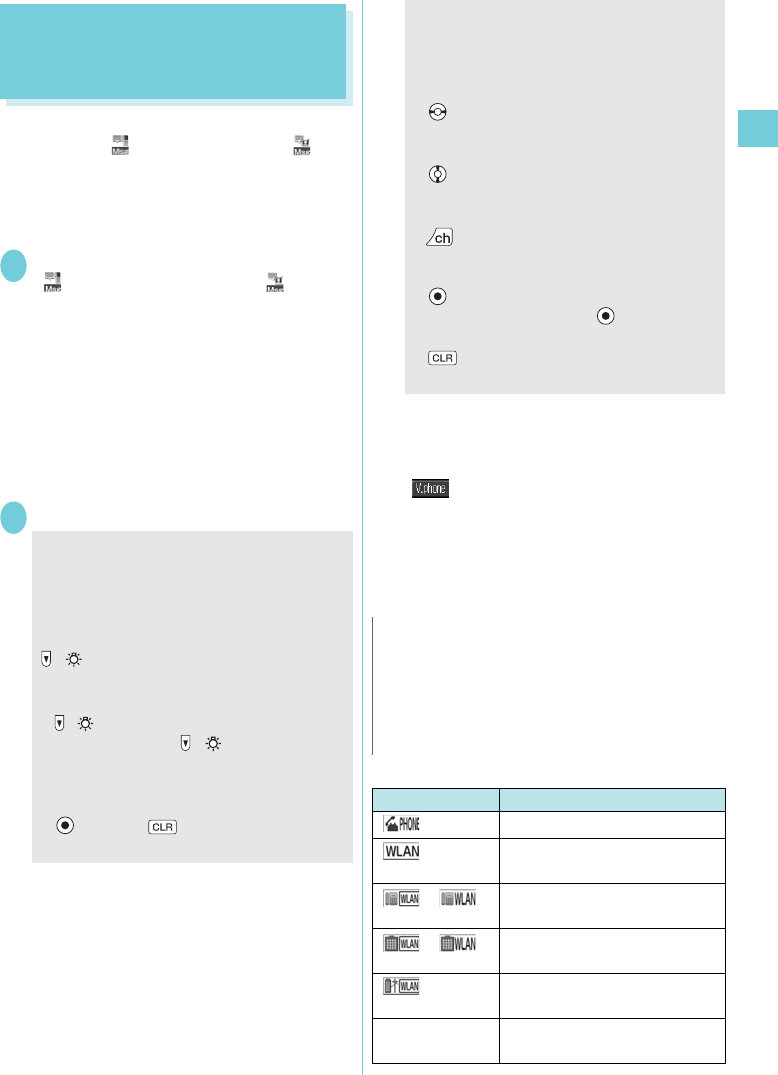
25
Continued on next page
Voice/Videophone Calls
Playing/Erasing Recorded
Messages, Voice Memos and
Video Memos
zWhen there is a recorded message which has not
been played, “ ” (Record message) or “ ”
(Record VP message) appears on the standby
screen.
<Example: To check the recorded message which
has not been played>
1On the standby screen
X
d
X
Select
“ ” (Record message) or “ ”
(Record VP message)
The “Play/Erase msg.” screen or “Play/Erase VP
msg.” screen appears.
A receive type icon appears next to a recorded
item. “★” appears if VP msg. or voice message
is recorded.
■To play the recorded message with the
menu operation
XiX‘LifeKit’X“Play/Erase msg.” or “Play/
Erase VP msg.”
2Select the item to play
■To make a voice/videophone or PushTalk
call to the phone number displayed while
playing a message
Xp (voice call, videophone call*1)/o
( ) (videophone call)/@ (PushTalk*2)
*1 : The “Enter phone number” screen (p.2) appears.
From here on, see “Making FOMA Voice/
Videophone Calls” (p.2).
*2 : Only one-to-one call is available.
■To erase the playing message
Xu (FUNC)X“Erase”X“YES”
■Displayed Record message/Voice memo icons
<Record message/Voice memo>
The FOMA terminal beeps and playback
begins. When the playback ends, the FOMA
terminal gives 2 short beeps and the “Play/
Erase msg.” screen reappears.
You can also play the messages by pressing
( ) on the standby screen.
■To play the next message while playing
a message
X[]
Each time you press ( ), the recorded
messages are played from the newest one.
Voice memos are played last.
■To stop the playback
X (Stop) or
The “Play/Erase msg.” screen reappears.
<Record Videophone message>
The playback starts. When the playback ends,
the “Play/Erase VP msg.” screen reappears.
■To play another message while playing a
message
X
■To adjust volume while playing a
message
X
■To switch ON/OFF of the speaker while
playing a message
X (FUNC)X“Speaker ON” or “Speaker
OFF”
■To pause the playback
X (Stop)
To resume playback, press (Play)
■To stop the playback
X
The “Play/Erase VP msg.” screen reappears.
N
zWhen 2in1 is in A mode or B mode, a receive type icon
or “★” does not appear for the recorded message
recorded in the unused phone number. When set to
“Dual mode”, a receive type icon or “★” appears for the
recorded message recorded in the both phone
numbers.
Icon Description
FOMA voice call record message
WLAN voice call (extension or
outside) record message*
/WLAN voice call (extension)
record message*
/WLAN voice call (outside) record
message*
WLAN voice call (dedicated)
record message
★Record VP message, voice
message
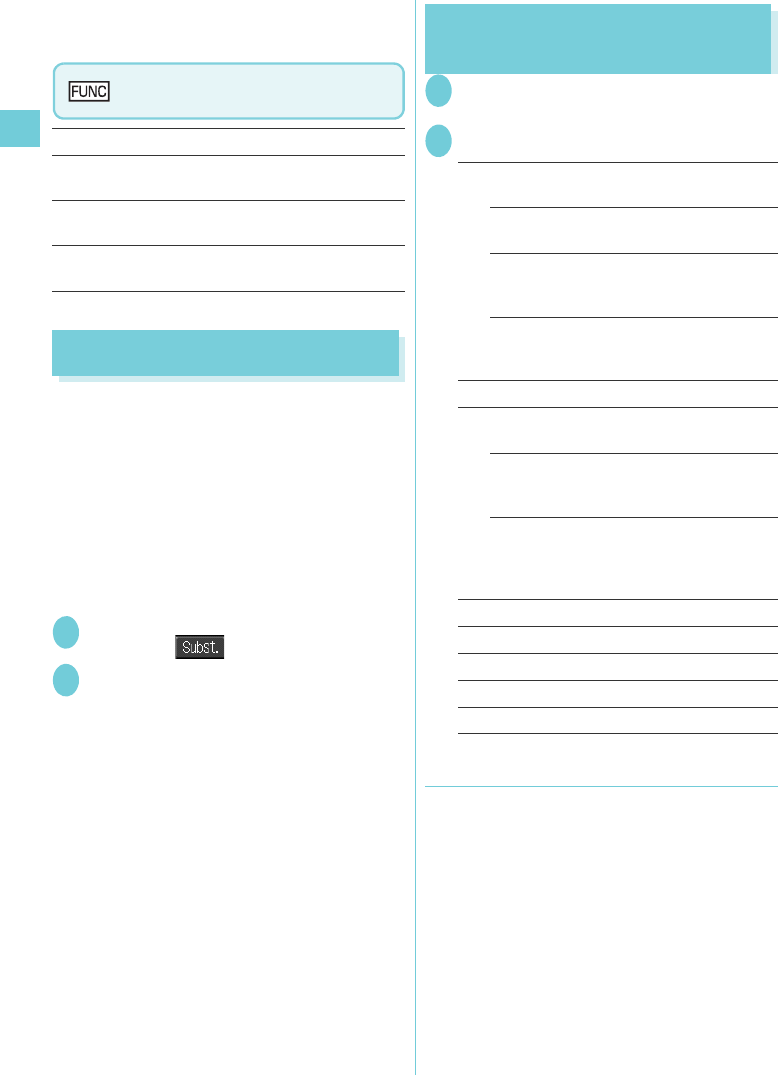
26
Voice/Videophone Calls
*: Icons displayed for WLAN voice call (extension or outside)
record message vary depending on the main device (SIP
server) settings.
Play/Erase msg. screen (voice/
video) (p.25)
Play……Plays the message.
Delete this……Erases one recorded message or voice
memo.
Delete rec. msg.*……Erases all the recorded messages.
Voice memos are not erased.
Delete all……Erases all the recorded messages and
voice memos.
*: Available only with the Play/Erase msg. screen.
Using Chara-den
This function sends a cartoon character instead of
your own image when you make a videophone call.
“What is Chara-den”
zYou can display your favorite Chara-den if you set
“Substitutive image” of “Select image” to “Chara-
den” beforehand.
You can also use Chara-den by setting Chara-den
in the phonebook or Ring tone/Image.
zTo switch from the camera image to Chara-den
during a videophone call, select “Substitute image”
from the function menu.
1When you receive a videophone call,
press d ()
2Control your character by pressing the
dial keys
Pressing a dial key makes the character perform
the action assigned to that key.
■To check the action list
Xw
You can also use b to select an action and
perform that action.
■To switch the action mode
Xu (FUNC)X“Chara-den set.”X“Change
Action”
“Whole” action and “Parts” action change.
“Using Chara-den characters”
Selecting the Image Sent to
the Other Party
1iX“Settings”X“Videophone”
The “Videophone settings” screen appears.
2Select any item:
Visual preference……Sets the visual preference for
videophone call.
Normal (default)……Standard setting for both
quality and movement.
Prefer img qual……Sends more finely
detailed video images. Best for motionless
subjects.
Prefer motion spd……Sends video images
with smooth movement. Best for fast-moving
subjects.
Select image→p.26
Auto redial as voice……Sets the operation
performed when a videophone call fails to connect.
ON……If a videophone call cannot be
connected, it is automatically switched to a
FOMA voice call.
OFF (default)……A message is displayed
notifying that you could not connect to a
videophone call, and the display returns to the
standby screen.
Remote monitoring→p.30
Display setting→p.28
Ntfy switch-mode→p.29
Hands-free switch→p.28
V-phone while packet→p.29
●Setting the image sent during
videophone calls <Select image>
You can select the image sent instead of the camera
image.
zYou can set a JPEG image whose file size is 100K
bytes or less and not larger than 854 dots wide ×
854 dots high, or a GIF image whose file size is
100K bytes or less and not larger than 854 dots
wide × 480 dots high or 480 dots wide × 854 dots
high (except for the files with restrictions).
zThe setting in this function is still retained after the
videophone call ends.
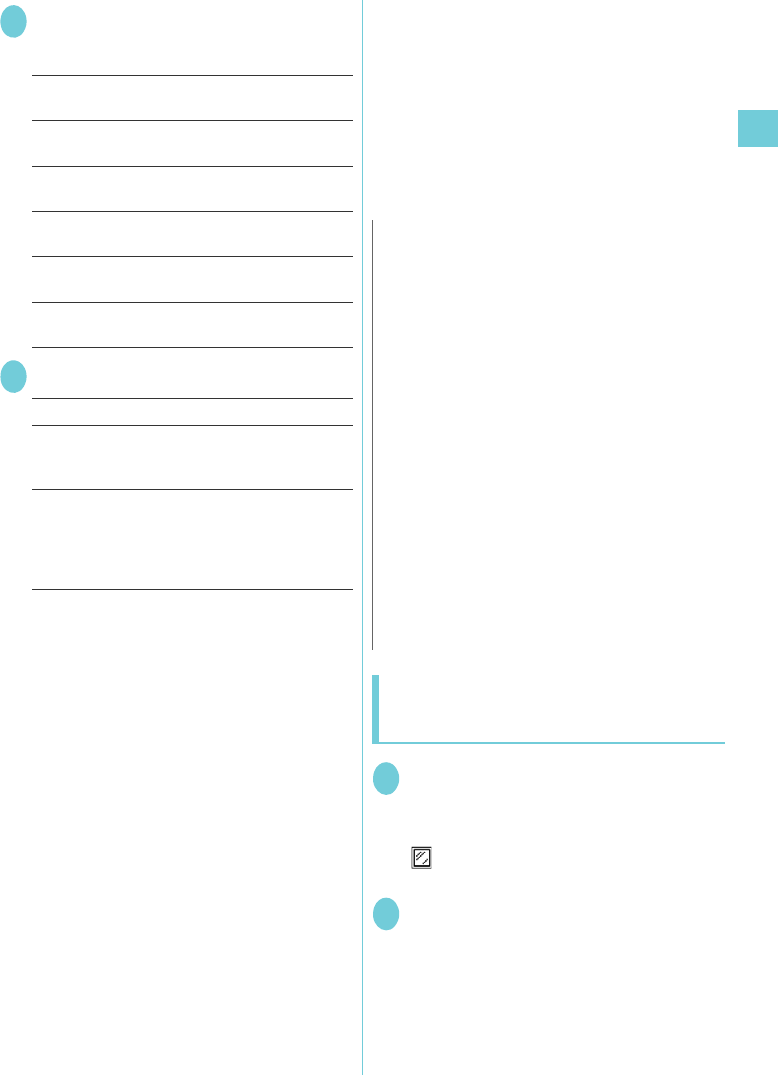
27
Voice/Videophone Calls
1Videophone settings screen
(p.26)
X
“Select image”
X
Select any
item:
On hold……Sets the image sent for a call on
answer hold.
Holding……Sets the image sent while holding a
call.
Substitute image……Sets the image sent as a
substitute image.
Record message……You can set the image sent
while recording videophone messages.
Preparing……You can set the image sent while
preparing for recording videophone messages.
Voice memo……Sets the image sent while
recording the voice memo.
2Select the image to be sent:
Pre-installed……Sends only a message.
Original……Sends an image and a message. To
change the image, select an image from My picture
from “Change setting” of the function menu.
Chara-den*……Sends the image selected in
“Substitute image”. Function menu of Chara-den list
screen. Priority order for Chara-den setting. To
change the Chara-den, select an image from Chara-
den list from “Change setting” of the function menu.
*: This setting is available only when “Substitute
image” is selected.
■Messages to be sent
For answer hold: “応答保留中 On Hold”
For holding: “保留 Holding”
For sending the substitute image: “カメラオフ
Camera Off”
For recording videophone message: “伝言メモ録画中
Recording”
For preparing videophone message: “伝言メモ準備中
Preparing”
For voice calls: “ 音声メモ録音中 Recording Voice
only”
Checking your appearance during a
videophone call
<Visual check>
1Videophone in-call screen (p.2)Xu
(FUNC)X“Visual check”
You can use the image from the front camera to
check your appearance.
“ ” is displayed during visual check.
A substitute image is sent to the other party.
2u (FUNC)
X
“Visual check off”
Visual check ends and the screen returns to the
state before the visual check.
N
<Visual preference>
zIf the signal quality deteriorates during a videophone
call, the image may become grainy or patchy
regardless of the settings in “Visual preference”.
<Select image>
zWhen you delete the original still image, the
“Pre-installed” image is displayed (sent) to the other
party.
zWhen the Chara-den character set as the substitute
image is deleted and the “Chara-den” substitute
image cannot be displayed, the pre-installed “Beans”
is sent. If you delete the pre-installed “Beans”, the
“Pre-installed” substitute still image is sent.
<Auto redial as voice>
zWhen a videophone call is switched and redialed as a
FOMA voice call, the call is charged as a voice call
and digital communication charges are not applied.
zWhen a call is redialed, only the voice call records are
logged in the “Redial/Dialed calls” record.
zEven if “Auto redial as voice” is set to “ON”, it may not
be possible to redial due to the conditions of the
network or the other party, such as busy.
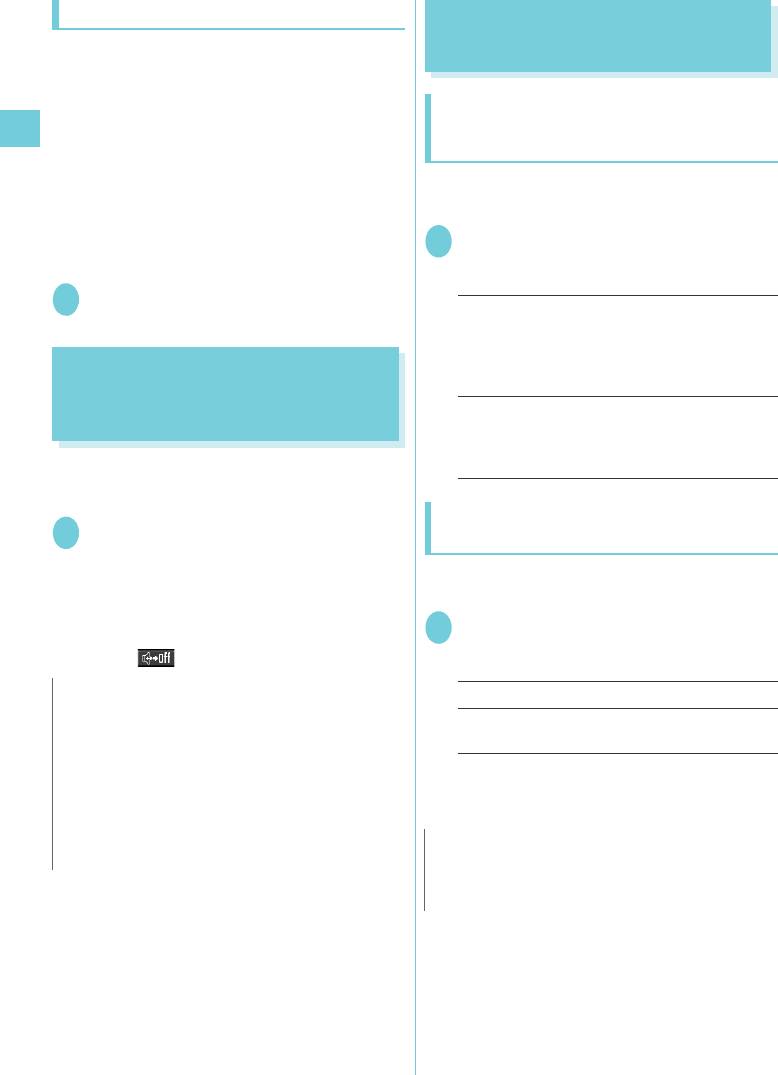
28
Voice/Videophone Calls
Enlarging the image to be sent
During a videophone call, you can enlarge the image
of yourself that is sent to the other party.
zIf you are sending the image captured by the rear
camera, you can enlarge the image by up to 4× (in
16 steps). The image shot using the front camera
can be enlarged by up to 2× (in 2 steps).
zIf you switch between the front and rear cameras
during a videophone call, the respective zoom
settings are retained. When a videophone call
ends, the image reverts to normal scale.
zYou cannot enlarge the image when you are
sending a substitute image.
1During a videophone callXPress v to
zoom in or out
Setting the Hands-free
Operation for Videophone
Calls
<Hands-free switch>
You can set the FOMA terminal to switch to handsfree
mode automatically when starting a videophone call.
1Videophone settings screen
(p.26)
X
“Hands-free switch”
X
“ON”
■Not to switch the mode
X“OFF”
■To cancel the handsfree mode during a
videophone call
Xo ()
Setting the Image Displayed
During a Videophone Call
Setting the image to be displayed on
the main screen and how to display a
camera image <Display setting>
You can set the image displayed on the main display
or how to display your own camera image.
1Videophone settings screen
(p.26)
X
“Display setting”
X
Select any
item:
Main display……Selects the main display for the
videophone call from “Other side”/“My side”. “Other
side” displays the camera image of the other party
and “My side” displays your own camera image on
the main display.
Front camera Reverse……Sets whether to display
your camera image as a mirror image (ON) or
normal image (OFF) on the FOMA terminal during a
call.
Decorating the videophone screen
<Decoration>
You can decorate the videophone screen (image from
your own camera) with stamps or frames.
1Videophone in-call screen (p.2)
X
u
(FUNC)
X
“Decoration”
X
Select any
item:
Frame……Selects a frame.
Stamp……Selects a stamp and sets the position to
paste.
■To remove a frame or stamp
Select “OFF decoration” from the function menu of
the videophone in-call screen.
N
zThe FOMA terminal does not switch to handsfree
mode automatically in the following cases even when
“Hands-free switch” is set to “ON”:
• While Manner mode is set
• When a flat-plug earphone/microphone with switch
(optional) is connected (however, the microphone
operation follows the “Select microphone” setting)
• When holding a call or Record message is activated
for the incoming call
N
zWhen “Front camera Reverse” is set to “OFF”, an
image is displayed in normal display, and you can read
stamps such as characters correctly.
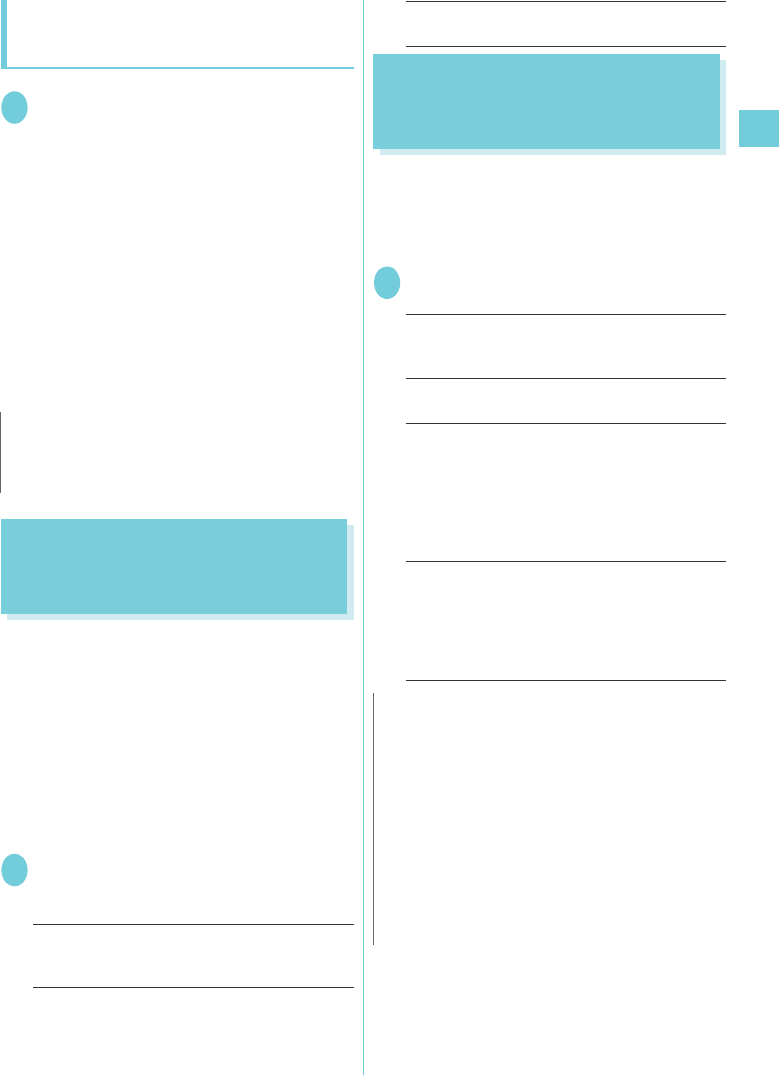
29
Continued on next page
Voice/Videophone Calls
Sending a message during a
videophone call (with a camera image
displayed) <Petit message>
1Videophone in-call screen (p.2)
X
u
(FUNC)
X
“Petit message”
X
Enter a
message
The message appears. The message
automatically disappears after about 15
seconds.
You can enter up to 16 double-byte characters
for a message.
■To cancel message entry
XErase the entire messageXt
■To erase a message manually after
displaying it
Xt (1 second or longer)
You can also erase a message by selecting “Off
decoration” from the function menu.
Setting for Switching Between
FOMA Voice Call and
Videophone Call
<Ntfy switch-mode>
You can set whether to notify the other party that your
FOMA terminal supports the switch between a FOMA
voice call and a videophone call.
zThe other party can switch between a videophone
call and a FOMA voice call when set to “Indication
ON”, but the other party cannot switch the call
when set to “Indication OFF”.
zThis function cannot be set in the following cases:
• During a call
• WLAN single mode
• Out of FOMA range
1Videophone settings screen
(p.26)X“Ntfy switch-mode”XSelect
any item:
Indication ON……Notifies the other party that your
FOMA terminal supports the switch between FOMA
voice call and videophone call.
Indication OFF……Does not notify the other party
that your FOMA terminal supports the switch
between FOMA voice call and videophone call.
Check Indication……Displays the “Ntfy switch-
mode” setting.
Setting the Answer Mode When
You Receive a Videophone Call
During i-mode
<V-phone while packet>
zAs the multi access function cannot be used for
videophone, incoming videophone calls during
i-mode communication or while sending or
receiving mails are handled according to this
setting.
1Videophone settings screen (p.26)
X
“V-
phone while packet”
X
Select any item:
V-phone priority……Switches to the videophone
ringing screen. When you answer the incoming
videophone, i-mode communication is disconnected.
Packet downld priority……Rejects the incoming
videophone call.
Voice Mail……If you have subscribed to the service,
videophone is connected to the Voice Mail service
center regardless of the “Activate”/“Deactivate”
setting of “Voice Mail”. If you have not subscribed to
the “Call Forwarding” service, the incoming
videophone calls are handled as the “Packet downld
priority”.
Call Forwarding……If you have subscribed to the
Call Forwarding service, call is forwarded regardless
of the “Activate”/“Deactivate” setting of “Call
forwarding”. If you have not subscribed to the “Call
Forwarding” service, the incoming videophone calls
are handled as the “Packet downld priority”.
N
zWhen “Front camera Reverse” is set to “OFF”, a
message is displayed in normal display, and you can
read characters correctly.
N
zEven when set to “V-phone priority”, you cannot
answer the videophone call if you are using multi
access such as using the i-mode communication
during a voice call.
zWhen set to “Packet downld priority”, “V-phone
answerphone” or “Call forwarding”, the received
videophone calls are recorded as “Missed calls” in the
“Received calls”.
zEven when set to “V-phone priority” or “Packet downld
priority”, “Voice Mail” or “Call Forwarding” service is
activated if the ring time for the “Voice Mail” or “Call
Forwarding” service is set to 0 second.
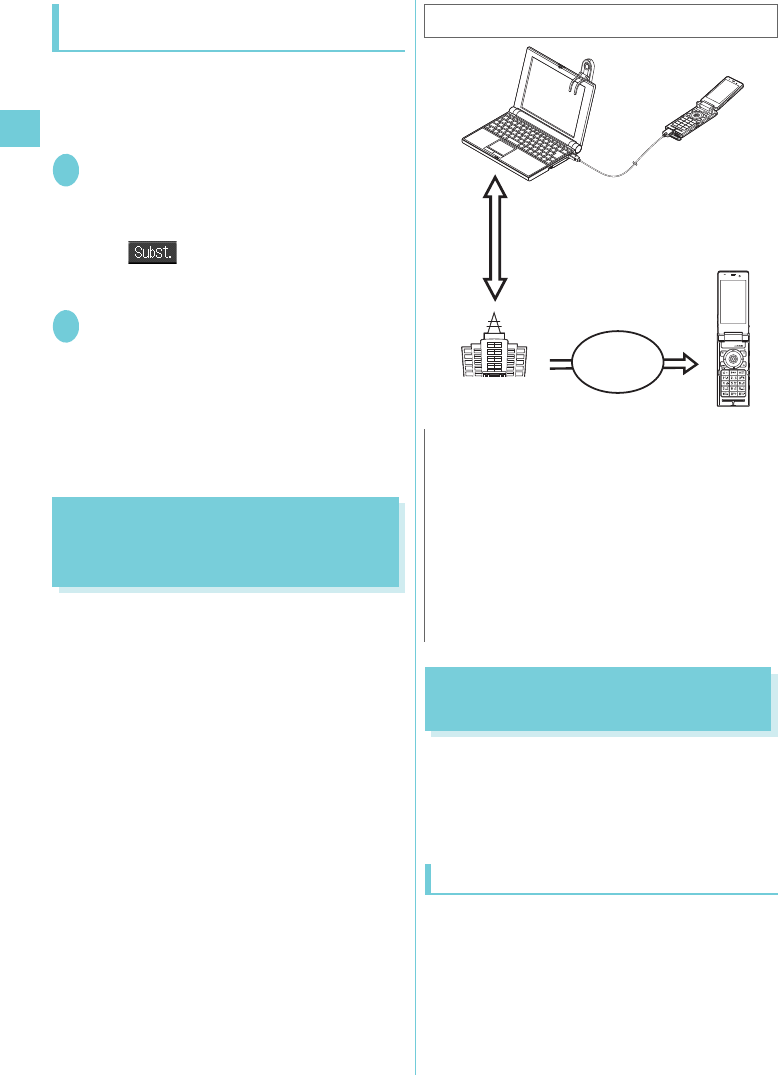
30
Voice/Videophone Calls
Receiving a videophone call during
i-mode communication
When “V-phone while packet” is set to “V-phone
priority”, you can receive a videophone call during
i-mode communication or while sending or receiving
mails.
1When you receive a videophone call
during i-mode communication, press
r
■To answer using the substitute image
Xd ()
The i-mode communication is disconnected and
the videophone in-call screen appears.
2To end the call, press y
■To continue i-mode communication
Even when “V-phone while packet” is set to “V-phone
priority”, you can continue the i-mode communication
by selecting “Call Rejection”, “Call Forwarding” or
“Voice Mail” from the function menu of the
videophone ringing screen.
Using the Videophone
Connecting to External
Devices
You can make or receive videophone calls from external
devices such as the PC by connecting to the FOMA
terminal with the FOMA USB Cable with Charge
Function 01/02 (optional).
To use this function, you have to install a videophone
application on the dedicated external device or PC
and prepare commercially available devices such as
an earphone/microphone and USB compatible Web
camera.
zSet the USB mode setting to “Communication
mode”. There is no specific settings for connecting
external devices.
zFor details on the operational environment,
settings, operations of the videophone application,
refer to the manuals supplied with the external
terminals.
z“ドコモテレビ電話ソフト” (DoCoMo Videophone
Software) (Japanese) is available as the application
which is compatible with this function.
You can download the Software from the website of
DoCoMo Videophone Software (Japanese).
(For details of the PC operating environment, etc.,
refer to the support website.)
Remote Monitoring
<Remote monitoring>
Remote monitoring is only available between FOMA
terminals or between a FOMA terminal and a phone
equipped with a 3G-324M-compatible videophone
function. onefone can be used as either the dialing or
receiving phone for remote monitoring.
Preparing the receiving phone
Set the phone number of the dialing phone (Other ID)
and the delay until remote monitoring begins (Ringing
time) on the phone performing the remote monitoring
(receiving phone).
zUp to 5 IDs can be stored.
http://videophonesoft.nttdocomo.co.jp/
N
zYou cannot make a videophone call from the external
device during a voice call.
zWhen you have subscribed to any service of Call
waiting, Voice Mail, Call Forwarding, and you receive a
videophone call from an external device during a voice
call, you can answer the call after ending the current
call. When you receive a voice call, videophone call or
64K data communication during a videophone call
from the external device, you can answer these calls
in the same way.
Base station
FOMA videophone
Connection speed:64K
FOMA
network
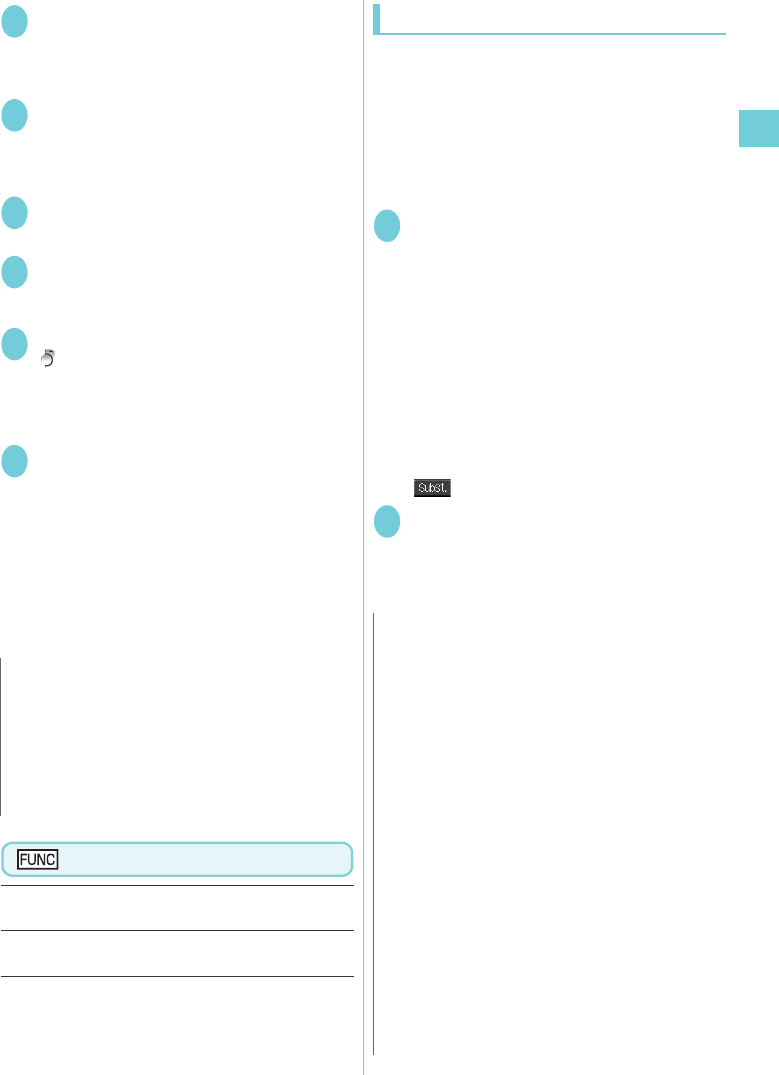
31
Voice/Videophone Calls
1Videophone settings screen
(p.26)
X
“Remote monitoring”XEnter
your security codeX“Other ID”
The “Other ID” screen appears.
2
“
<Not recorded>”
X
Enter the phone
number to be monitored as Other ID
■To change the previously stored Other ID
XSelect ID you want to change
3Press t to return to the remote
monitoring screen
4“Ringing time”XEnter the ring time
(003 to 120 seconds in 3 digits)
The ringing time is set.
5“Set”X“ON”
“ ” appears on the standby screen.
■To turn remote
monitoring off
X“OFF”
6Position the FOMA terminal
In remote monitoring, the image from the front
camera is sent to the dialing phone.
Put the receiving FOMA terminal on the
monitoring position, ensuring that it is switched
on and unfolded.
If it is left folded, only the voice is sent and the
camera image is not sent. The substitute image
is sent with “カメラオフ Camera Off” written on
the image.
Other ID screen (p.31)
Look-up address……Enters the address referring to the
phonebook, Dialed and Received calls records.
Delete this/Delete all……Deletes one or all Other IDs.
When all IDs are deleted, the “Set” setting is set to “OFF”.
Starting/ending the remote monitoring
zTo perform remote monitoring, you should always
make a videophone call with caller ID (phone
number) notification provided from the FOMA
terminal registered as Other ID on the receiving
phone.
zWhen the FOMA terminal is used to receive the
remote monitoring, images and sound from the
dialing phone are both played.
1Make a videophone call to the
receiving phone
After the ringing time set on the receiving phone
has elapsed, remote monitoring begins.
The video image from the receiving phone is
displayed and the sound comes from the
speaker on the dialing phone.
■To answer a videophone call (with camera
image) on the receiving phone without
triggering remote monitoring
XPress r before the set ringing time has
elapsed
To answer with a substitute image, press d
().
2To end the call, press y
The call duration is displayed and remote
monitoring ends.
You can also end remote monitoring by pressing
y on the receiving phone.
N
zWhen positioning the FOMA terminal, set “Video-
phone” in “Vibrator” to “OFF” to prevent the FOMA
terminal from moving when receiving calls.
zIf the ringing time set for “Voice Mail” or “Call
Forwarding” on the receiver side is shorter than the
ringing time set for remote monitoring, “Voice Mail” or
“Call forwarding” takes priority.
N
zCalls from the phone number stored in the Remote
monitoring settings can be received as a remote
monitoring call even when Dial lock or Omakase Lock
is set.
zIf caller ID notification is not provided, the call is
received as a normal videophone call and not as a
remote monitoring call.
zRemote monitoring cannot be performed if any of the
following functions is set at the same time:
• Public mode (Driving mode)
• Manner mode
• Call rejection/acceptation*
• Reject unknown*
*:When “Call acceptation” is set for a phone number
other than ID or “Call rejection” is set for ID, or
when “Reject unknown” is set and ID is not stored
in the phonebook.
zSpecific ring tone for Remote monitoring is used and
cannot be modified.
zRing tone is played at the volume set in “Videophone”
in “Ring volume” (if the ring volume is set to “Silent”,
“Level 1” or “Step”, the volume is set to “Level 2”).
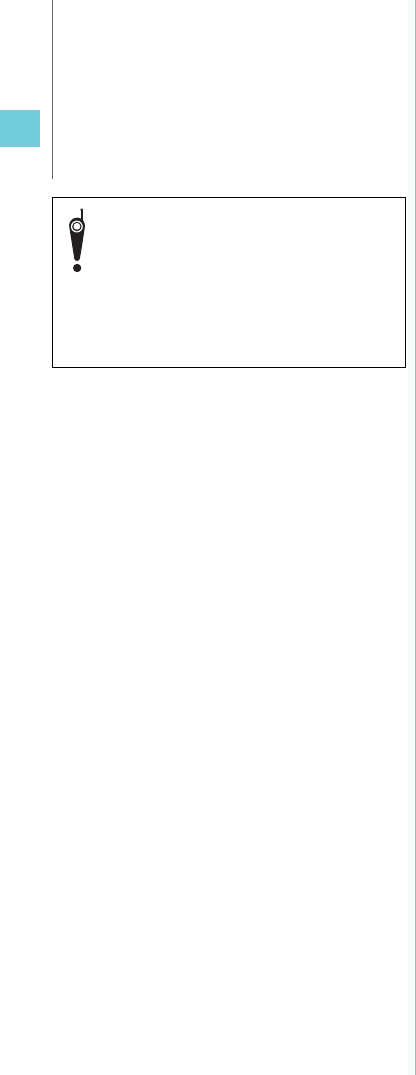
32
Voice/Videophone Calls
zWhen receiving a call for remote monitoring, the
flashing color is set to “Gradation” and the flashing
pattern is set to “Standard”, regardless of the
“Illumination” settings.
zAnswer hold cannot be set while receiving remote
monitoring. Press y to end the call.
zYou cannot switch cameras from the receiver during
remote monitoring.
Please be considerate of the privacy of
individuals around you when taking and
sending photos using camera-equipped
mobile phones. Improper use of the FOMA
terminal in ways that constitute a serious
public nuisance may be punishable under
laws or ordinances intended to prevent such
behavior (privacy protection laws, etc.).
N